#iamyegarts
Text
I Am YEG Arts: Heather Shillinglaw

Mixed media artist Heather Shillinglaw expresses her Indigeneity and familial oral histories through collages that employ sewing, painting, and sculpture methods. She grew up in Ministik near Cooking Lake and now lives in Edmonton and has a strong connection to the land and to her heritage; Nêhiyawêwin /Cree, Dene/Chipewyan, Salteaux/Ojibwe, and Scots/French. Over the course of her career, she has shared land-based teachings in art workshops with thousands of students of all ages, taken on activist work to highlight the importance of the natural world to inspire others to preserve what is left, and has exhibited her work extensively. In this week’s I Am YEG Arts feature, we get to know more about Heather Shillinglaw.
Tell us about your connection to Edmonton and why you've decided to make it your home.
Growing up outside of Edmonton, we would come into town to do our shopping, and all that kind of stuff. And I always thought it was so fancy, and a fantastic place to live with all these great shops and beautiful river valley to pick berries or whatever. It maintained a consistent interest for me to live here and settle here. Now that I have my family, my husband and my two daughters, we call it home. And it's not far from the place where I grew up, and my family. So, we're kind of surrounded within Edmonton. I also have an ancestral connection to the land in that they harvested medicines, mostly berries here, which I'm very glad to say that saskatoons grow prevalently in our River Valley.
What is your creative process like? And what motivates you as an artist?
I started out mostly as a mixed media artist, project based, so when I make art, I'm very material based. There's kind of a relationship with the material that I start building a language within the work I'm creating. It's either through symbolism, the materials, or the project base -- the goal -- which is talking about the environment, preservation of what's left, to creation of the piece itself. Right now, I'm obsessed with sewing, and I'm sewing on hides and then I'm sewing on big florals. I collect and harvest like a mouse. That's my animal spirit and I see things large and giant, and I'm very humbled by the land.
In my pieces I’m using anywhere from three to six different types of sewing machines to create the work. When I'm sewing, I'm thinking about that kinship and relationship to the landscapes, like the maternal landscapes. It's all nature based and it's all about the healing plants and medicines that are in our land.
How do you choose the materials you work with?
That's a tricky one because I'm constantly collecting like a mouse. Another aspect in thinking about conservation of our land and not causing problems, I use a lot of recycled materials and mediums. In the body of work that I'm still creating, ᒫᒥᑐᓀᔨᐦᒋᑲᐣ ᑯᑖᐄᐧᐤ mâmitonêyihcikan kotâwîw, – my mind digs in the soil like a turtle -- an exhibition that's happening right now in Halifax at the Mary Black Gallery -- I'm sewing on to hides and it's kind of an eagle eye’s perspective. Through that I'm doing tufting, beading, and sewing into bodies of water that relate to the landscapes of where my ancestors hunted and harvested. Inspiration sources come from here, there and everywhere. So, you know, I'm a mouse that acts like a magpie.

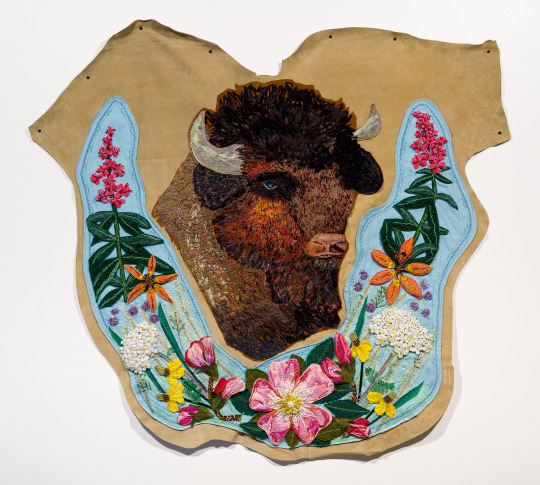
Top: Detail of ᑮᓯᑌᐳᐃᐧᐣ ᓵᑳᐦᐃᑲᐣ kîsitêpowin sâkâhikan cooking lake by Heather Shillinglaw. Bottom: Gravemarker Bison from the Whiskey Script Series by Heather Shillinglaw.
Where does your inspiration come from?
The inspiration comes from the land itself. For a lot of my projects, my inspiration source is my mother: through storytelling about the land, and her memories from our Nohkums, our grandmothers, and how they harvested from the land, right down to the specific berries, or the relationship that the moths share with the trees and how it provides a kinship relationship to the land itself. Then through that, I'm taking oral stories and I'm also looking at other forms of research, such as archival research. I've worked with ethnographer Ruth McConnell and I've been working with Elder and Knowledge Keeper Lynn Desjalais/Lush from the Sandy Bay Reserve (she's a relative of ours, I think that's an added bonus). And Anne Cardinal, who's from Saddle Lake Reserve. There's a cultural connection, an artistic connection, a research base. So, there's many different platforms in my resources and where I make my art from.
Marilyn Dumont is another source of inspiration. Marilyn is a Métis poet, and we share common lineages in where our inspiration sources come from. I've been sewing her poetry into bodies of water, and I sew my own poetry now because she's given me a lot of strength to do that. So that's another aspect of my work – using poetry and prose to talk about what's going on in the art. I'm so honoured that she said she's willing to work with me and we continue to work together on projects.
You've had the opportunity to exhibit your work nationally and internationally as well as participate in residencies abroad in Paraguay and Argentina. How was your artistic practice influenced by these cultural exchanges and how was your work received?
That was so much fun. 2009 was a bit of a banner year for me. Beatriz Ventura , who is the Canadian consulate located in Buenos Aires, for Argentina and Paraguay, connected with me and we talked about medicines, and she talked about her ancestors and how they hunted and harvested. Through that I sat on panel discussions, I exhibited my work, and then I did a little bit of a residency. I was quite excited and engaged by what was happening with the Indigenous people out there and how it was almost like going back 200 years for their discovery of the oil rights in the land. I gave some advice, from my ancestors and their trauma and problems that we've had in the past. I got invited to go around with an anthropologist in Mendoza and she took me up into the mountains, and we met the Indigenous tribes there. It was a phenomenal experience.
The more I thought about it, the more I wanted to talk about plant sustainability, which is in my practice today. Then I got invited by a conference attendee from Paraguay, Asunción to stay in her home. I got a chance to meet all these wonderful people there, networked with them, created workshops for the conference that I attended, gave a panel discussion presentation of my work, and then I also got a chance to work with the UNICEF school out there as well. I kind of became a little bit of a political activist. I'm not in your face in my politics; there are political statements within the art itself. And the more I create my work, the more I'm concerned about the land and preservation, because our oil and gas industry is affecting our water tables, it's in our system and there's some relationships of what Industry Canada is doing to our land that is very disconcerting. As an artist, your job and your role is to make sure you carry your message through your art, so that's where art becomes an activist statement. And I don't want to be in your face. I want people to want to understand. And that's where you can access more of a deeper, profound way of understanding the art, understanding culture, and understanding our planet and preservation.


Top: Gravemarker Fox from the Whiskey Script Series by Heather Shillinglaw. Bottom: Painted Red by Heather Shillinglaw.
What would you say is your greatest strength as a creative?
I have taught many artists and residencies over the years, and I worked at the Art Gallery of St Albert as their first Indigenous Visual Arts Programmer; I take pride in that. Whenever I'm teaching, I take it upon myself to inspire people. That’s important and supports my practice. That's another hat that I wear as an artist. Through my Elders, I've learned that a big part of our culture is sharing, and you share with humility. Like, the information that was given to me, you hand it down for the next generation to inspire them. And they're probably not going to make the same work that you're going to make; the goal is to inspire, and that’s why I teach.
Tell us a little bit about what you're currently working on or hoping to explore next.
At the Centre of Contemporary Craft of Nova Scotia there is an exhibition of my work right now, it closes on July 2nd. I will be going to see the exhibit and attend a series of things going on out there. It’s a body of work called ᒫᒥᑐᓀᔨᐦᒋᑲᐣ ᑯᑖᐄᐧᐤ mâmitonêyihcikan kotâwîw, – my mind digs in the soil like a turtle, and it's basically large landscapes and a body of work that showed here last year at the Alberta Craft Council. It does come back here in the fall, in September and October at the Art Gallery of St Albert. We're going to be doing some exciting activities, workshops and talks.
In January, I have an exhibition at the McMullen gallery. I'm going to be doing some workshops and artist talks and events. And as a sneak peek, for Gaagige Giizhig - Ishpeming (Forever Sky) (the Sky Above) I'm going to be turning the gallery to space! Those are works are on black panels, and there's thirteen of them, and they're not small either -- some of those panels are larger than me, so maybe like 8' x 5’ ft. MSHKAWJI GIIZIS (FREEZING MOON) – OCTOBER for example, is one of them, it’s the frost moon, so they're really different.
And then I have another body of work, it's called Whispers in the Forest, and it's going to the Esplanade Gallery [in Medicine Hat]. It's part of a larger group exhibition. In 2026, I have a solo exhibition at the same gallery and I'm just working through that. I'm going to be focusing on learning ancestral languages from language keepers: Saulteaux Denesuline language, Anishinaabe language, and Nêhiyawêwin Cree. It's going to be a massive mouse trap, a life-size mouse trap that focuses on live, eat, sleep, repeat.

Detail of MNIDO GIIZIS (SPIRIT MOON) – JANUARY by Heather Shillinglaw.
Tell us about a local artist group or organization that is doing great work in the community that you think more people should know about.
I would start off by saying CARFAC Alberta is fantastic and great to work with because they do a lot of programming to help artists survive as artists. There's a lot of versatility in the art world, but it's challenging to survive as an artist. They do all kinds of workshops to help people, anywhere from writing grants, to what's next, or how to ship your art internationally and that sort of thing. So, there's lots of opportunities for artists to learn from them.
And then I would say the Art Gallery of Alberta is fantastic. I’ve shown my work there, I sell my work at the art rental sales, and I've had opportunities to work with them and be a special guest artist, teaching workshops for them that a benefactor had paid for. There are phenomenal opportunities for artists to connect with them. Outside of that, there is the Art Gallery of St Albert. Emily Baker and Leah Louden are fantastic. They also sell my work out there, and they do amazing programming that is so unique. You can go in by donation and still access a lot of the arts just in that space itself. So those are some really good places that do so much in the community.
The Rowles and Company Gallery also sells my work. I'm saying support our local galleries because you know, they really struggled to get through COVID, so it's really important to share that message with others.
And I didn't even mention the Edmonton Arts Council, that they offer so much programming, so many grants and possibilities for artists themselves. I've been honored to be a recipient of those grants and organizations for money to create my works.
I am also so thankful that I have been inspired by Shirley Norris Shillinglaw, who's my mother, and my family that supports me. Keith Macmillan and my daughters tolerate bits of thread and my messy nature. They’ve been very generous to allow me to do that.
About Heather Shillinglaw
Heather Shillinglaw is a project-based artist adapting art materials using sewing, painting and sculpture methods. Growing up in Ministik near Cooking Lake, she now lives in Edmonton, Alberta. Shillinglaw is proud of her heritage; Nêhiyawêwin /Cree, Dene/Chipewyan, Salteaux/Ojibwe, and Scots/French. Shillinglaw shares land-based teachings in art workshops to thousands of students of all ages, throughout her career. She becomes an activist, her voice in sharing through art she hopes to inspire the importance of the natural world to inspire preserving what is left. Exhibiting her work nationally and internationally, she is humble in acknowledging the awards and Grants that help her projects, inclusive of a recent award Leighton Studio stay at the Banff Center for the Arts; the Gerin-Lajoie Studio. Previous exchanges abroad in Paraguay and Argentina working with anthropologists, medicine women of Tobian- Guarani and Mapuche healers in South America, and other shows/cultural connections abroad. You can learn more about Heather here.
3 notes
·
View notes
Text
I am YEG Arts: Ray Dak Lam

Since taking the plunge into freelancing, Ray Dak Lam has made big waves as a graphic designer and illustrator. Known best for his signature geometric designs and vibrant colour palette, Ray is sought after locally and internationally with some big-name clients under his belt. In just a few years as a freelancer, Ray has embraced new opportunities from his first mural project to taking part in Adobe’s Global Creator series — this week’s I am YEG Arts story puts the spotlight on Ray Dak Lam.
Tell us a little bit about yourself and about why you’ve made Edmonton your home.
I'm an illustrator and designer from Edmonton. I graduated from the MacEwan Design Studies program in 2014. I got my creative career started working at a couple of advertising agencies and at a smaller design agency. Since then, I’ve become a full-time freelancer — that's what I've been doing for the past few years. I really like the creative freedom of freelancing, and that I get to explore more of my own personal style as well as choose my own clients and hours.
I was born in Edmonton and have lived here all my life. All my friends and family are here, I feel like Edmonton will always be my home. Edmonton has also shaped who I am as an artist in many ways — the people, especially those I went to school with and have worked with, all my coworkers, friends and experiences growing up — I think it all inevitably influences the subject matter in my work and the themes that I introduce into my illustrations. And now I hope to contribute what I can to the city's creative culture.

What drew you to graphic design and illustration? How did you get your start?
During my first year of high school, I took a graphic arts program, and my very first project was to recreate a font or typeface. It was through typography that I discovered my love for graphic design. And that's when I began considering it as a career for myself.
As for illustration, drawing has always been part of my life. I was always drawing as a kid, and I was never really good at any other subjects in school. Art was the only subject that I was passionate about. It is what motivated me and pushed me to pursue it all through childhood until now.
Tell us about someone who mentored you or helped set you on your path.
One of my first mentors was Andrew Benson. I worked with him at my first job at an advertising agency. He taught me a lot about branding, design, and the advertising industry in general. He’s passionate about print design and illustration and taught me their importance when it comes to design. He really inspired me when he went off to start his own studio and I hoped for myself I could follow in his footsteps.

Tell us about a big professional risk that you have taken and how it has influenced where you are today.
I would say taking the leap into full-time freelancing. It was scary in the beginning. I got laid off during the beginning of the pandemic from my advertising agency job. And at least for me, it was hard to find another full-time position. I was only able to land various short-term contracts, and some freelance projects here and there. In that moment I saw it as an opportunity to try this freelancing thing full-time since it has always been a dream of mine.
The pandemic and getting laid off were the push I needed to take the full leap into freelancing. It really changed my career for the better and it has opened up a lot of opportunities that I never would have thought possible. I have had a chance to work with and collaborate with a lot of clients that I had thought were unattainable. And I’ve gotten to collaborate with many other incredibly talented designers and creative people in Edmonton.
Who's someone inspiring you right now?
Someone who is really inspiring me right now is an illustrator from Vancouver, Tom Froese, he makes Skillshare courses, through which he teaches his approach to commercial illustration; YouTube videos, podcasts — all on the topic of illustration, and aimed at people interested in the creative industry. I've done a couple of his Skillshare courses and I'm attending one of his workshops at the RGD DesignThinkers conference coming up May 30 -31 in Vancouver.
He inspired me to find a focus and explore it as deeply as I can. His style has a very distinctive voice and he mentioned in his videos that it was the result of repeating a set of techniques over and over again once he found something that worked for him, so this really inspired me to seek a similar path for myself in terms of finding my own unique stylistic voice.
What does your creative process look like? Where or how do you usually begin?
For me, it always begins in my sketchbook. I try to bring my sketchbook with me anywhere and everywhere I can. Especially when I'm traveling, during those long plane rides and train rides where I can just let my mind wander and draw freely — whatever comes to mind. After that I pick my favorite sketches and vectorize the artwork, then bring it into Photoshop where I use my drawing tablet to add texture to bring more of my own personality to the artwork.
I enjoy creating abstract and geometric compositions because it's a meditative and calming process for me. I started a personal project during the pandemic called "Shape Studies", and it's been an ongoing project ever since. With a focus on the fundamental elements of shape, line, and colour, I explore freely within those basic fundamentals to create the most interesting compositions that I possibly can. I also use similar principles of geometry and abstraction when I'm illustrating other subject matter, such as animals, landscapes, people, etc. I'll continuously remove any unnecessary details and distill them into their most essential and fundamental forms.
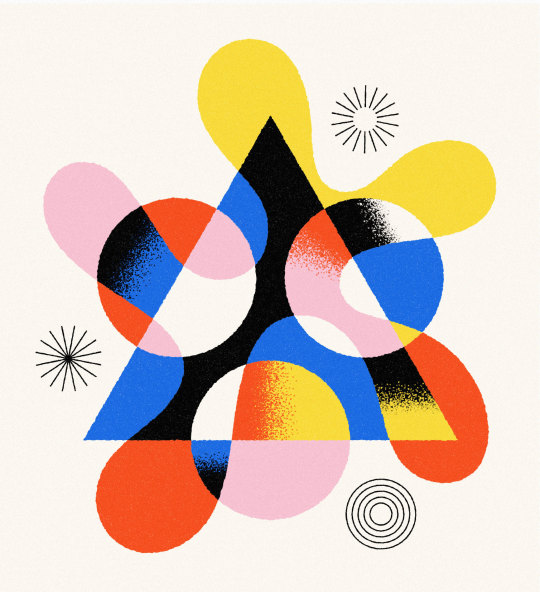
Tell us about one of the most exciting projects or opportunities you've had.
One of the most exciting opportunities I had last year was the chance to collaborate with Adobe on their Global Creator series. It was a series where they featured different artists from around the world and they decided to feature me. They had me self-shoot a ton of footage around my studio, capture shots around Edmonton, and create a short tutorial explaining some of the techniques that I use to create my illustrations.
It was both exciting and nerve wracking appearing on video, but I'm glad I did the project because I love the way it turned out in the end.

Tell us about a favourite local project and a favourite international project.
One of my favourite local projects was for Doughnut Party. They had me create a mural for their Ritchie location. I collaborated with Jennifer Konanz — she's a local mural and sign painter. She's incredibly talented and I feel grateful to have collaborated with her. She helped translate my artwork into a large-scale mural. It was really cool to see my artwork on such a large scale, which I don't get to see very often.
A favourite international project would be a commission for GoDaddy to create a set of illustrations centered around Asian Heritage Month and Lunar New Year. The project was really special to me because I got to express my own cultural background and upbringing as an Asian Canadian. Also, it was fun to illustrate dragons and dumplings in my own style.
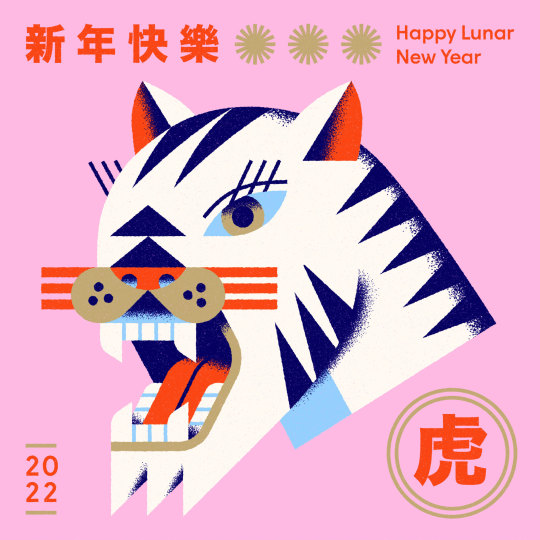
What are you currently working on and what do you hope to explore next?
I've just completed the 36 days of type challenge on Instagram yesterday and it was really satisfying to see it through from start to finish! The project invites designers, illustrators and artists from all over the world to create a letter or number each day for 36 days straight. It was my first time taking part in the challenge. I really love to explore creatively, and I feel it’s important to work outside of client deadlines and budgets. It’s somewhere I can freely express my voice and craft and refine my style.
It was great seeing all of the other work from artists and designers that I follow, as well as discovering new artists to follow. Freelancing can be isolating at times, so participating in this challenge made me feel like I was part of this larger community all undertaking this daily activity together.
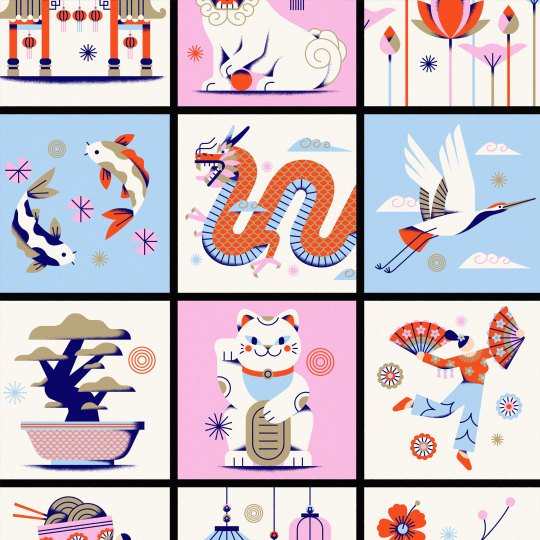
What excites you most about the Edmonton arts scene right now?
All the projects centered around Edmonton's Chinatown like Chinatown Greetings, created by Emily Chu and Shawn Tse, and Jordon Hon’s A Portrait of Chinatown documentary series. And many other creative projects that are supported by the Chinatown Transformation Collaborative (CTC). All these projects play a really important role in the revitalization of Edmonton's Chinatown. It's really inspiring to see so many people from different creative backgrounds coming together for a common cause.
Want more YEG Arts Stories? We’ll be sharing them here and on social media using the hashtag #IamYegArts. Follow along! You can keep up with Ray on Instagram, Behance, Dribbble or visit his website.

About Ray Dak Lam
Ray Dak Lam is a designer and illustrator from Edmonton, Canada. His work is characterized by its simplicity, utilizing vibrant colours and bold geometric forms as the basis for direct, communicative imagery. He works primarily on brand and illustration focused projects with clients around the world, such as Asana, GoDaddy, and McDonald's.
3 notes
·
View notes
Text
“I am YEG Arts” Series: Cindy Baker

Things I’ve Forgotten, performance at Southern Alberta Art Gallery 2018, photo by Jane Edmundson
Cindy Baker: a contemporary artist with an interdisciplinary research-intensive practice, working at the forefront of queer, gender, race, disability, fat and art discourses. From early on as a performance artist with what she describes as a “taboo body,” body politics and fat liberation have been integral to her artistic practice. Cindy’s next project not only pairs exceedingly well with some of her most-oft visited themes, it will also exercise her well-honed research chops. The Edmonton-based artist was recently recommended for the Coronation Recreation Centre public art project. Currently under construction, the Coronation Recreation Centre will serve as a community hub for central-north Edmonton that meets the leisure, health and wellness needs of residents of all ages. For the project, Cindy will create site-specific freestanding sculpture(s) for the facility’s large exterior entrance plaza.
This week for the blog, we talked with artist Cindy Baker about her initial plans for her new public art commission and got the scoop on her solo show currently on at dc3 Arts Projects.
Tell us about yourself and your connection to Edmonton.
I'm a queer, fat, disabled, contemporary, interdisciplinary and performance artist based here in Edmonton. I was born and raised in Leduc, and I moved to Edmonton in the 90s to go to school at the University of Alberta, where I got a Bachelor of Fine Arts. And I worked at the Fine Arts Building Gallery, the Works Art & Design Festival, Latitude 53 Gallery, Harcourt House Artist Run Centre, and Metro Cinema. So, I was deeply involved in the arts community before I decided it was time to move away. I was away for several years but Edmonton's home to my family, my support system, all my networks of people, my communities, and I just couldn't stay away.
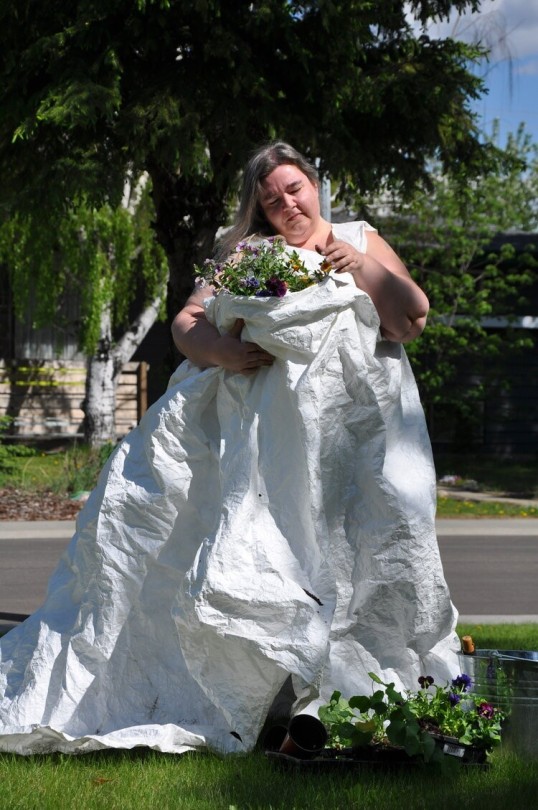
States of Resolution, performance at Edmonton private residence 2021, photo by Grace Lee
How did you get your start as an artist? Was it always plan A for you?
My parents were both teachers, so I always thought that I had to grow up to be a teacher too, but I always really wanted to be an artist. My mom's sister was an artist and I just idolized her and everything she did. And I was always drawing, painting, sewing, sculpting, crafting — doing crafts and art of all kinds. I never had a preferred medium, but I was just always making and working with my hands, so I always knew that no matter what I did for a living, I was always going to be an artist. I don't think I ever expected to make a living at art, but there is no way that I wasn't going to make art throughout my life.
Is there a narrative or discourse you find yourself returning to in your work?
I have a few major themes running through my work. To start with, the body, especially fat bodies and othered bodies are a major theme in my work. As a performance artist with a fat body and — what I call a taboo body — I knew it was always going to be read into the content of my work, so very early on in my career I made a point to become involved in body politics and fat liberation, to really inform the work and enrich the content. Productivity is another theme running through my work, questioning and resisting the moral imperatives of body, health and self-care that imply there are good bodies and bad bodies. That to strive towards being a good little productive cog in the wheel is a moral good. Therefore those who can't, or who fail to be this really strident definition of productive from our work lives to how we enact self-care, are inferior humans and less worthy of care or social support. So that's one of the major themes I think that has run through my work in the last decade.
And there are a lot of beds in my art and not on purpose, that's just kind of how it goes, beds and relaxation and toys and leisure activities like hot tubs and tricycles and swimming pools. I just keep coming back to rest and that idea of resisting productivity in the name of privileging and honouring the body's needs and care for one another being just as important as self-care.

Dream Come True, installation at Remai Modern 2020
These are subjects that have become very topical in recent years, have you noticed a difference in the reception to your work?
I think my work used to be a bit ahead of the curve and now I think it's very sort of right in what's being talked about in the world right now, especially to do with self-care and these neoliberal impulses towards productivity. And the world falling apart has us all questioning what we should be doing with our lives and our time. I think, especially since the pandemic started, we've all been rethinking what it is that we want to do with our time and our lives.
Tell us about the Coronation Recreation Centre public art commission that you've recently been awarded. What drew you to the project?
I'm really excited about it. I think the fact that the work will be connected to a leisure centre, which is also paradoxically basically a triathlon training facility, meshes so well with the themes I come back to again and again in my work. There's nothing leisurely about athletic training. It's work, and it should be valued as work, even if it's not the productive kind of capitalist labour that we've been taught to value. And on the flip side, I want to talk about leisure in a way that disconnects it from any need to perform, to perform work especially. I want to honor those who train and who engage in leisure activities as well, and those who can't or don't or won't, for any number of really valid reasons connected to bodies and time and desire and priorities and ability. Whether that's a body ability, financial ability, or what have you.
Is this your first foray into public art? Tell us about how it overlaps or differs from your overall art practice.
It's not exactly my first foray into public art, considering that my performance practice is often interventive and happens in public spaces, and is meant to be encountered by and engaged with by a general public. But it's definitely my first permanent public sculpture project. I don't consider myself a sculptor in the traditional sense, but I do make a lot of objects. And in my object making practice, no matter how hard I try, I can't seem to stop making big things that really have a presence. So, I do feel like this project is a natural extension of my practice and hopefully a new direction for my practice to grow into.
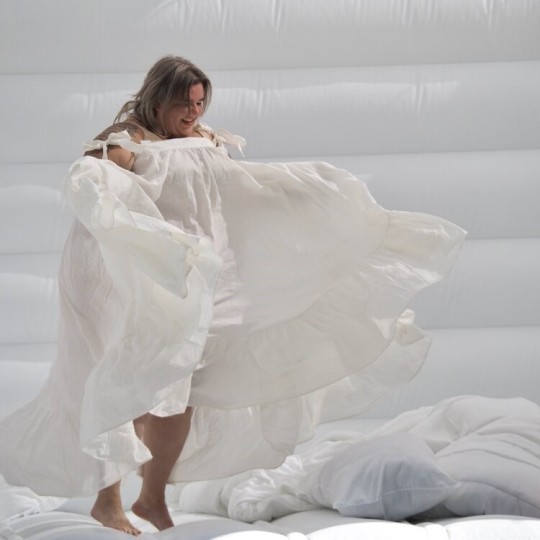
The Three Graces, performance with Mary-Anne McTrowe and Shanell Papp at MacEwan University 2021
Tell us about your interdisciplinary research-based approach. Will it be an important part of your creative process for this commission?
Yeah, I don't think any other project that I've done has put my research chops to the test as much as this one will. It'll be a really integral part of the creative process for this project. In research-creation practices in general, the research exists as much in the making as in engaging in traditional research methods. Which for me, and for this project specifically, means that all the making I've done in my practice to date exists as a body of research that's led me to this commission and will really inform and shape the work, and then in turn, the making of this work is its own research that will lead me to my next projects; be they new artworks, journal publications, conference presentations or incorporation into my university teachings. They're all one big whole in my work.
As you're working on this commission is it spurring on new ideas or potential new directions that you'll take from here in your practice?
As I develop the ideas for this project, I can see the threads coming out of other work that I've done. I don't think that that's unique, I think most artists have common threads that run through the work. But it's really interesting as I've grown and progressed in my career. It used to be that things felt very individual and from one project to the next, I didn't necessarily see those threads, but now I really see them throughout all the work.
What does community mean to you and where do you find it? What will your community engagement approach be for this public art project?
Community for me is family, whether that's blood family or chosen family, social networks and support systems. Community is my stomping grounds, workplaces, and favorite haunts. So, I find community where I find my people and that's for me, artists, fat community, queer community, thinkers and lovers of culture. For this project, more than talking to geographic community, I want to consult with people and organizations that are attached to communities that are traditionally underserved by public art projects and by recreation centres too; people with reduced access to financial resources, people who feel disconnected from that kind of facility, queer people and disabled people, people with mental health concerns. All those whose various demographics put them into the categories of those who don't fit those definitions of moral good, as defined by their abilities or their bodies or their productivity.
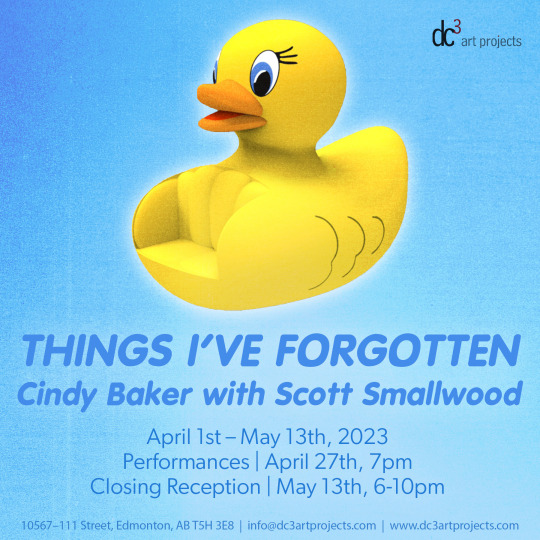
Tell us about your current solo exhibit at dc3 Art Projects.
The show is called Things I've Forgotten, and it's part of an ongoing work about my dreams. I spent about 10 years collecting a journal of my dreams. I would wake up every morning and write down my dream from the night before, and then never look back on it again. After 10 years I decided to start rereading my dreams and I was fascinated by the fact that they were so old and had long been forgotten because even though I wrote them down, I would forget about them shortly afterwards, like I think most of us do. I would read these dreams and they would be completely new to me and were completely foreign. So, I got to experience them for the first time, but then slowly the memory of the dream came back to me, and I could see all the images vividly and hear the sounds and smell the smells. It was as though the dreams had really happened and I was remembering them as a memory and at the same time I was kind of going through having heard stories about this trauma that happened when I was a kid but not remembering it, and I thought what if by reliving these dreams and pulling them to the surface what if I could bring this trauma to the surface as well? So, it sounds a bit like it was meant to be therapeutic, but I'm an artist and nothing is quite so literal, so I went about this project of working with my dreams to try and change myself as a person and see how I could be affected by this.
One of the works in the show is a collaboration by Scott Smallwood and me — he's a local audio artist — and together we recorded 20 different voice actors reciting my 10-year journal of dreams and created this really beautiful cloud of sound of all these overlapping voices, it's an 8-channel audio installation of all these overlapping voices. It's difficult to pick out any individual dream or any individual voice, but it does create this soundscape when you go in, that adds to the surrealness I think and beauty of it. It's very dreamlike.
What excites you most about the Edmonton arts scene right now?
I think Edmonton is exciting in general. I've only been back in a permanent way for a few years, but I think growth and change is what's most exciting to me. The arts scene here kind of feels like it's breathing and changing and growing and maybe that's exciting to me because I feel like I'm changing and growing too, which is exciting in its own way and makes me feel connected to Edmonton. I have to say that I love Edmonton cinema, theatre, festivals, music and dance, but my heart really belongs to visual and performance art. So, the galleries and the artists and the public art are what really grounds me to this city.
Want more YEG Arts Stories? We’ll be sharing them here and on social media using the hashtag #IamYegArts. Follow along! You can catch Cindy Baker’s exhibition Things I’ve forgotten at dc3 Art Projects. It’s on until May 13, and as part of the exhibit programming, there will be performances on April 27 at 7 pm and a closing reception on May 13 from 6 – 10 pm. Keep up with Cindy on Instagram, Facebook, or visit her website.

About Cindy Baker
Cindy Baker is a contemporary artist based in Western Canada whose work engages with queer, gender, race, disability, fat, and art discourses. Committed to ethical community engagement and critical social enquiry, Baker's interdisciplinary research-based practice draws upon 25 years working, volunteering, and organizing in the communities of which she is part. She moves fluidly between the arts, humanities, and social sciences, emphasizing the theoretical and conceptual over material concerns. Baker holds an MFA from the University of Lethbridge where she received a SSHRC grant for her research in performance in the absence of the artist's body; she has exhibited and performed across Canada and internationally. Helping found important community and advocacy organizations over the course of her career, Baker continues to maintain volunteer leadership roles across her communities.
2 notes
·
View notes
Text
“I Am YEG Arts” Series: Layla Folkmann

Layla Folkmann, photo provided by the artist.
Ever looked around a room full of talented peers and wondered if you had the secret sauce to stay in the game? If you ask Layla Folkmann, she’ll tell you there’s no secret to it at all—just stubbornness, consistency, and fortitude. Some days, that looks like slogging through the rough patches. Other days, it looks like international success. No matter what the day though, Folkmann is never without gratitude for her unshakable foundation—one built on encouragement and education, with no backup plan in sight.
Mural artist, painter, and public-art advocate, this week’s “I Am YEG Arts” story belongs to Layla Folkmann.
Tell us about your connection to Edmonton and how it’s influenced your path.
As a free-range child of artist parents, I have many fond memories of being immersed in the Edmonton arts scene. From running through gallery openings and eating an excess of cheese off unattended platters, to bouncing restlessly in theatre seats, these early experiences have undeniably influenced my life in both obvious and imperceptible ways.
Education and early encouragement are undeniably the foundation on which my art career rests. I attended Victoria Composite School and the Grant MacEwan Fine Arts program, which provided a solid technical vocabulary that I consistently apply to my work to this day. It’s all these elements that have allowed me to confidently throw myself into the professional realm with the knowledge that I could make it work as an artist.
What themes are you drawn to in your work?
Luminosity and vibrant harmonious colours are aesthetic themes that I work with in all aspects of my painting practice, whether abstracts, portraiture, or large-scale mural work. I'm constantly searching for exciting colour combinations in the world around me to translate into my painting.
Honest portraits of real people is another consistent theme that my artistic collaborator, Lacey Jane, and I explore in our public mural work (Lacey & Layla Art). We find portraiture to be a compelling tool to encourage human connectedness by representing authentic members of a community and, hopefully, strengthening local pride. We aim to celebrate each community's unique character and urban diversity and to highlight community members and the human experience. We also explore what we like to call “techno nature,” which is a combination of design-based graphic elements and natural scenes. These pieces are our exploration into our contemporary interpretation of the natural world.
How do large-scale murals and public art play to your strengths as a storyteller?
By the nature of their size and location, murals can be an impactful and compelling storytelling tool. They are accessible in public spaces and memorable with their imposing format. People have explored this format from prehistoric cave paintings and the Mexican revolution, to the graffiti in New York subway stations. The power of the format is undeniable, reaching everyday people in everyday places.
Art speaks a universal language, and what continues to excite me about public murals is that they remove both the real and perceived barriers of a gallery or museum space and release artwork into the public sphere.
Public art has an unparalleled ability to transform urban—and even rural—spaces into an open living gallery that is free and accessible to everyone. It redefines communal areas and creates new opportunities for engagement, curiosity, appreciation, and ownership for the beautification of often neglected or forgotten spaces.
Each story we tell is curated to the space and the community in which we create the artwork. Each new location provides an opportunity for a new narrative to touch on the core aspects of the neighbourhood and the people who exist within it.
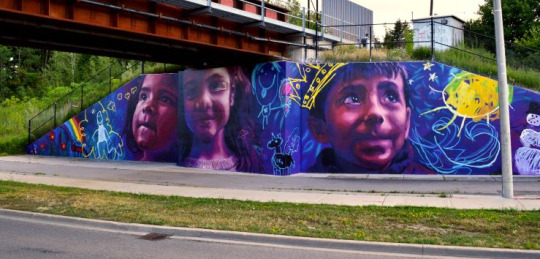

Top: Colour Outside the Lines by LALA, photo provided. Bottom: Larger Than Life A Mr. Chi Pig mural by LALA, photo provided.
What’s the first thing you ever made that inspired your artistic path? Did you know then that you’d unlocked something?
It has always been clear to me that art is what I was going to do; there was just never any other option. The form in which my career took was a happy accident and had everything to do with timing and chance. When I envisioned a career in the visual arts as a youth, becoming a mural artist wasn’t even on the radar. One opportunity presented itself, which led to the next, and then I ended up here. Luckily for me, there has been an international boom for mural art and I got on board early enough and have been riding that wave for over 10 years now. It seems that there is a new appreciation on the part of funding agencies and municipalities for the inherent value that murals can bring to a community.
Tell us a little about LALA (Lacey & Layla Art) and what that collaboration has meant to you.
My artistic collaboration with Lacey Jane has been fundamental to my continued growth as an artist. We initially met while studying Fine Arts at Grant MacEwan University in 2009 and have nurtured our “artnership” ever since. It is surprising to everyone, including ourselves, that we’ve maintained such a close friendship after the hundreds of travel hours and months of 12+ working hours a day in the rain, snow, and +40C heat. Each project has its unique challenges and unforeseen obstacles, but humour continues to be our greatest coping tool. Our enthusiasm for art is what brought us together, and it’s what continues to fuel our creative partnership. Together we push each other to take on bigger and more ambitious creative challenges.
What’s one piece of advice someone gave you growing up that turned out to be true. What’s one piece that didn’t hold up?
A professor of mine once mentioned that stubbornness, consistency, and fortitude are the qualities it takes to become a successful professional artist—not raw talent or early success. I see this truth demonstrated consistently within my artistic peer group. The people who make it work just simply do it, and then they keep doing it. They slog through the rough patches, make the right connections, and see it out the other side.
“Have a backup plan” was advice that didn’t hold up for me, personally. Perhaps it seems reckless to bet all your chips on red, but fully committing gave me the determination and motivation to pursue my passion without deviation or distraction.
What does community mean to you, and where do you find it?
Community is quite simply who one surrounds themselves with. I believe in making active choices rather than passive choices about those who remain in my close sphere. I consider those who I surround myself with to be a defining aspect of who I become as a person. I aim to have a community that I admire, full of positive, enthusiastic, and hard-working people who challenge and encourage me to become more of that myself.


Portraits by Layla Folkmann, photos provided by the artist.
When you’re struggling to stay on task, what’s your favourite way to procrastinate?
Productive procrastination seems to be a method I'm particularly fond of. I tell myself I can concentrate better when I “clean out my corners,” but I have a suspicion that is just an advanced avoidance technique. I also collect hobbies, such as soapmaking, felting, fermenting, carpentry, etc. Any of these can take precedence at inopportune times.
Tell us a little about what you’re currently working on or hoping to explore next.
My most substantial and challenging venture to date has been designing and building my own tiny house on wheels. It has been an ongoing, character-building exercise in creative problem-solving and patience, but it has me hooked. I am thrilled with the range of new skills it has taught me and the obstacles I've overcome. I did a whole lot of things wrong the first time before I could eventually get them right.
New and exciting mural projects with LALA are always in the works, and the winter months are dedicated to planning the next mural tour. Summers in Canada seem to disappear pretty quickly, but the winter allows me to decompress, plan, and create some studio work.
Most of my artistic career has been about mastering realism and representational work, but over the last few years, I have been exploring abstract painting to take a break from portraiture and the faithful replication of photographs. My abstracts provide me with a much-needed refuge in the pleasures of simple colour, light, and composition.
What excites you most about the YEG arts scene right now?
After relocating to Montreal for nine years and then returning to Edmonton, I’ve viewed the strength and quality of the YEG arts scene through a new lens. What I used to view as small, I now can appreciate for its intimacy, strength, warmth, and tight-knit community. The YEG support that our mural work has received throughout the years has been quite touching, and I feel quite at home.
Want more YEG Arts Stories? We’ll be sharing them here all year and on social media using the hashtag #IamYegArts. Follow along! Click here to learn more about Layla Folkmann, Lacey & Layla Art, and more.
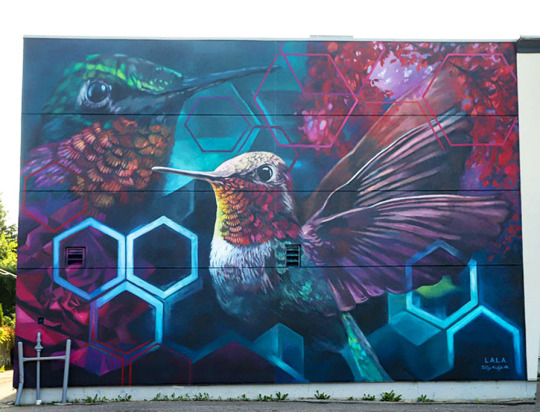
A Charm by LALA, photo provided.
About Layla Folkmann
Layla Folkmann is an Edmonton-born internationally recognized mural artist and painter. She studied Fine Art at Grant MacEwan University (2009), École d'Enseignement Supérieur d'Art de Bordeaux (2015), and graduated with distinction from Concordia University in Montreal (2016) with a major in painting. For over a decade, she has dedicated her practice to socially and culturally engaged public art as part of LALA (Lacey & Layla Art) while fostering a passion for portraiture, realism, and the representation of compelling characters. Layla has collaborated on hundreds of murals across Canada and internationally in places such as Iceland, France, and northern Uganda. Layla has travelled extensively, having backpacked through nearly 40 countries. Over the past decade, she has received numerous grants, notable public projects and awards such as the 2021 Edmonton Artist Trust Fund Award. Layla is currently designing and building her own self-sufficient tiny house and maintains a full-time studio practice in her home town.
5 notes
·
View notes
Text
I Am YEG Arts series: Donita Large
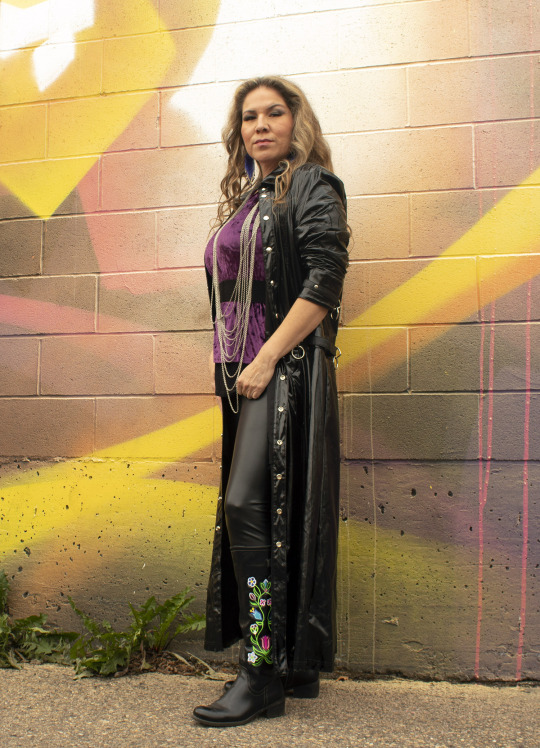
Donita Large is a Cree singer-songwriter whose powerful stories and beautiful melodies pack an emotional punch. With a passion for singing that started at an early age – having been immersed in Métis, country, and gospel music all her life – Donita started out singing at funerals and weddings in her community of Saddle Lake First Nation, AB. Understanding how music can be a powerful tool in healing, during the pandemic she took the plunge into releasing her own songs. A year and a half later, Donita has released three original songs, hitting number one on the Indigenous Music Countdown, and she shows no signs of slowing down.
This week’s “I Am YEG Arts” story focuses on Donita Large.
Tell us a little bit about your connection to Edmonton and what keeps you living and working here.
I grew up in my community of Saddle Lake First Nation. I finished high school, and I came to the city for post-secondary, like many people do. And once I landed here, I started to get connected with the Indigenous community here. I think once you lay your roots someplace and you start getting involved in community it's harder to leave. I really love the music community in Edmonton. It's very dynamic and there's so many amazing artists, so it's pretty easy to stay.
What drew you to music as a creative outlet, and what guides or informs the music that you make?
That is a really big question. I have a very musical family back home in northeastern Alberta – in Saddle Lake, but also Moose Mountain where my mom's side of the family is. I grew up listening to my uncles play fiddle and guitar, and so for me, music was just a part of life. It wasn't like I chose it. I can't imagine having grown up without music.
When I came to the city, I didn't have those connections right away, and so I started to reach out to different organizations and places. What really got me going was when I started jamming, playing ukulele and just getting together and having some fun, trying out some new things. And it got me writing music as well. I had only written one song at that point, and I don't know how other songwriters are, but I think there's a bit of imposter syndrome. Like, can I really write? Is this something that I can do? and you kind of limit yourself. So, I started to write more music and that inspired me to focus on creating more music.
And then it became, well, what am I going to write about? What's the focus? What got me writing originals is that I really wanted to write songs that honored my ancestors, and honored the stories that I think people are just starting to hear, and some of the stories that are just starting to be told. Some [songs] have that Indigenous inspired sound and some are specific to things that are in my heart and in my mind around reconciliation and around the stories that I just feel like it's a good time to tell.
In what ways does your Indigenous heritage influence your art?
I think it influences everything. It's not something I feel like I can separate in any way. It's just who I am and that's my experience in this world. One of my songs, “Reconciliation Sky” honours residential school survivors; those who went to residential school and didn't come home, and those who went and had the experiences they had at residential school. I have many people in my family who went to residential school, including my father. And so, I felt it was an important story.
The very first song that I wrote – it's not the first song I released – but the first song I wrote was called “Ancestors in my Bones”. It was just something I felt. I pulled over on the side of the road and wrote these lyrics, and it was something that I felt like I just needed to sing.
And while jamming with a group of ladies, the song that came out was a song about women's empowerment. Having gone through unhealthy relationships in my past and thinking about that story, I wrote a song called “Going to Walk that Line” about creating healthy boundaries and feeling really good about what I'm going to accept in my life and what I'm not going to accept. All of those pieces are influenced by who I am as an Indigenous person.
As a storyteller, what narratives or inspiration do you find yourself returning to in your songs?
Being a mother, I contemplate what messages I want to put out in the world because I know that music and words have power. Knowing that my daughter is going to be singing along and hearing these songs, that impacts the words that I say. But also, as much as I want to tell the stories of our experiences, whether it be hurt or intergenerational trauma, I also want to tell stories of hope or healing.
One of the songs that I wrote that I haven't released – it'll be a part of what the work that I’ll be doing this year – is called “Sweetgrass”, and it's a really beautiful healing song. It makes people feel good when they hear it, and if I can sing a song that allows people to feel really grounded, connected, and happy in their heart to hear it, that makes me feel good about the music I'm putting out in the world.
But to balance it, I also wrote a song that has a lot of angst in it. It's a really heavy, hard rock song that hasn't come out yet. I'm kind of all over the map when it comes to genres because I really love all different kinds of sounds. I think that at the end of the day, a lot of it just has to do with my own experiences of wanting to share a story and also do some education through my lyrics.
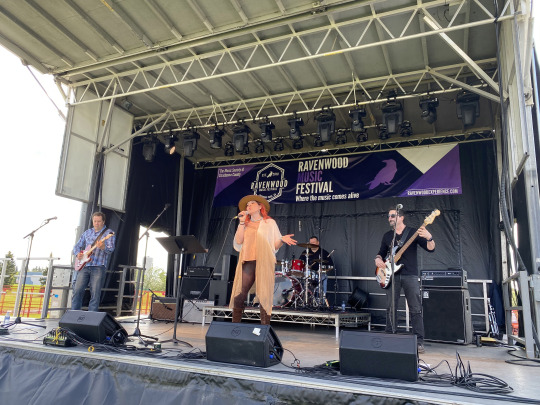
Tell us more about your new song “Reconciliation Sky” and your experience working with mentor/producer Chris Birkett.
I had the privilege of getting to meet Chris [Birkett] when I was looking for a producer to do “Ancestors in my Bones”. When I first wrote the song, I'd been performing it with a drum or a rattle and I was trying to figure out how to get a sound for the recording with more of a “World Rock” feeling to it. I was able to connect with the music publisher Eric Alper and I said, look, this song would be the kind of song that someone like Buffy Sainte-Marie would appreciate. He told me Buffy doesn't produce her stuff anymore; she's at a time in her life where she gets other people to do that work. Then he asked, “would you like to meet her producer?” And I was like, that sounds like a great idea! I was so surprised that I asked a question, and here I was being introduced to Chris.
We connected on Zoom because he lives in Toronto. He was so humble, and he's got a spiritual, cool vibe and it was so easy to talk to him. And then I sent him my song and he loved it. He did the producing for that first song.
I was able to get a grant through the Edmonton Arts Council to go to Toronto and be mentored by Chris for a week. And during our time together, we wrote four songs together and “Reconciliation Sky” was one of those songs.
It was interesting because when you work with somebody where energies connect, things flow really easily. I told Chris that I felt it was really important at this time that I tell this story. I want to find a way to be able to talk about and honour the 215 that started in Kamloops with the unmarked graves, and how that story is continuing across Canada. You know that story hasn't ended. And I think because it's not in the media, I'm not sure how many people are really aware of how many residential schools are still recovering family members. I thought that was an important story to tell.
Thinking about how to tell that story, Chris and I were talking and he said, “I have this really beautiful lullaby that I used to sing my son that I wrote for him. And I have this melody. Do you want to hear it?” And I said sure. He played it for me, and I was like, that's the sound. The lullaby piece is so fitting because in my second verse I acknowledge the mothers didn't have a chance to sing those lullabies because their children were at residential school.
What advice would you like to share with emerging artists?
I think part of it is that you can’t wait for people to make it happen for you. Regardless of what medium you're in, it's important to make connections and to ask those questions and get out there. And know that there's going to be times that you're not going to know what you're doing. There were times when I was trying to figure out how to release music. I was like, this is so beyond me and I had to reach out to people in the industry. I have a cousin who had released music in Saskatchewan and he was doing really well so I reached out to him and I'm like, hey, how do I do this? He gave me tips, and then I started reaching out to a mentor and he would give me tips. The more that I asked questions, the more people were helping. Sometimes people won't help, for whatever reason, and that's OK. But there's lots of people who do want to help, and I think the hard part is to stay on top of it; you’ve got to stay engaged. There's a lot of work involved. It's not something that just magically happens.

Tell us about what you're currently working on and what you hope to explore next.
Well, I have some shows booked, I'm doing shows with my guitar player Anthony King. Anthony King is the lead guitar player for Buffy Sainte-Marie, and he happened to move to Edmonton. I'm very grateful he's here. And then also I have a band – Donita Large and the Small Band. I've done some festivals and different shows and I'm hoping to hit more stages.
My daughter is also doing a show with us in March. She'll be doing some pow wow dancing/ fancy dancing for the SkirtsAfire Festival, as a part of our show Nikâwiy, meaning ‘my mother’ in Cree. I'm with the Indigenous women's group called Nîpisîy (Nîpisîy meaning ‘willow’ in Cree) along with Sherryl Sewepegaham, Debbie Houle and Cindy Paul.
And I've decided that I want to finish an album. At this point I've released three singles, and I’ve decided that this is the year that I want to focus on getting an album together and getting that out. I'll be working with Chris Birkett again, and hopefully either going to Toronto or having him come here.
What excites you most about the Edmonton art scene right now?
When I think about what exists in Edmonton there's so much dynamic art that is happening in so many different areas. For example, prior to Christmas the Indigenous Artist Market had done shows and I got to sing at three different weekends. Just to walk through and see like 30 Indigenous artist vendors – that didn’t exist before. It used to be harder to find beadwork or mukluks that were made here. To have so much available, to me, that's one way people have come together.
When it comes to music, you can go find live music – amazing live music – any night of the week. It's really a matter of how much time you have and whether you can make that work. But there's just so many amazing musicians and so many different genres that are represented. And it feels like it's a very welcoming community. I think the opportunities that are presented now, especially for young people if they choose to get into art, there's so much more support and there's so much more opportunity than there ever was before.
Want more YEG Arts Stories? We’ll be sharing them here and on social media using the hashtag #IamYegArts. Follow along! Click here to learn more about Donita Large.
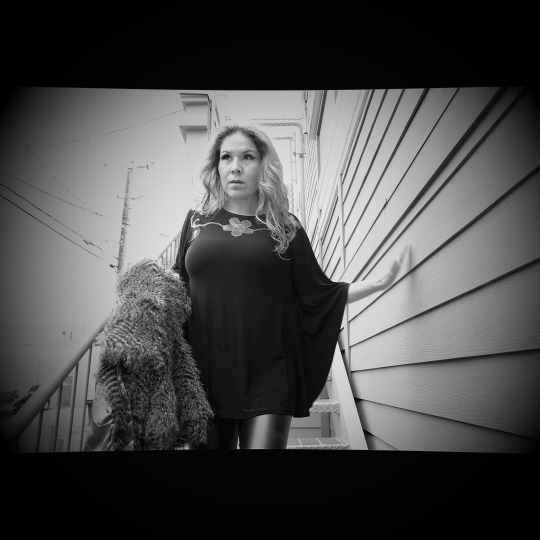
About Donita Large
Donita Large is Cree from Saddle Lake First Nation and is a singer-songwriter and has been mentored as an associate vocal coach. She has an education in social work, addictions and adult education and is a Four Directions Wellness Specialist and a Circle of Safety Women’s Family Violence Facilitator. Performing solo or in groups, Donita has sung in Indigenous women's acapella and drum groups, for special events like in the Indigenous & Black Choir for a Johnny Reid CCMA performance, an Indigenous quintet performance at Carnegie Hall, and on intimate stages like the Pêhonân stage at the Edmonton International Fringe Festival. In May 2021, Donita created and produced the music for a University of Alberta educational video called “Territorial Acknowledgements: Going Beyond the Script”.
3 notes
·
View notes
Text
"I am YEG Arts" Series: Jeff Collins

Jeff Collins at Collins Studio Gallery. Photo provided by the artist.
For Jeff Collins, the key to having a successful career as an artist is showing up every day. His consistency and commitment have defined his long career. “The inspiration shows up when you’re at work,” are words he lives by. At the end of his studies, advice he received from his Red Deer College painting instructor, Joseph Reeder, to “forget everything he’d been taught,” inspired him to lock himself away in his studio for six months and shut out all distractions. During that pivotal time nearly 30 years ago, his practice in landscape painting took form, and he’s maintained a studio in Edmonton ever since. In 2019, he took a big leap with the opening of Collins Studio Gallery, which serves as his working studio, a classroom where he teaches oil painting, and a gallery that welcomes community and is an exhibition space for emerging artists and curators to show their work.
This week on the YEG Arts blog, we catch up with Jeff Collins.
Tell us about your connection to Edmonton and what keeps you living and working here.
I was born in Edmonton and studied through high school here. I moved away for about ten years and during that time, I lived in Jasper. In Jasper, I had my first apartment and when I wanted to put art up on the walls, everything I saw was just cliché posters, and so I thought “I can do better than this, look at all the scenery around Jasper.” My mother was a painter, so it was always part of my life although I didn’t pursue it much until then. With some encouragement from those who saw my early work, I decided to study art and design at Red Deer College [now known as Red Deer Polytechnic] and the University of Alberta. I then went on to Grant MacEwan Community College [now MacEwan University] to study arts administration.
After returning to Edmonton, it was really the first time I was part of the arts community here and it was just so supportive and amazing. Some of the highlights for me at that time (the early nineties) was the Works Art & Design Festival. They were so, so instrumental in creating community and making Edmonton a supportive place for artists. Latitude 53 was an influential gallery for me, also Arts Habitat Edmonton, and of course the amazing river valley and the fabulous people here. I’ve been here ever since working away as an artist and really being part of the community.

By Jeff Collins (left to right clockwise): Turtle in the Woods 001, acrylic on paper; Heartland, acrylic on canvas; and King of the North, acrylic on canvas. Photo provided by the artist.
What’s one of the biggest professional risks you’ve taken, and how did it influence where you are today?
As an artist, you take risks every single day and you’re putting yourself out there, and if you’re true to your craft, you’re really pulling deep inside of you to pull that out and to put it out there, where other people can see it. That’s always so risky. It’s kind of like every day as an artist is a risk. I worked at the Alberta Craft Council for many years and when I decided to quit and work full-time in my studio, that was a pretty huge risk financially. I am very happy that I did that, though it’s always been a gig-to-gig kind of thing since, and I worked out of my studio between contract positions. It’s been four years — I can’t believe it — since I opened Collins Studio Gallery! I signed a lease, and I trusted that if this is meant to be, it was going to happen. So, leaving my full-time job and signing the lease on where I am now and opening a gallery — where I also teach classes and have my studio — were all big risks! Sometimes I think “well I don’t take any risks,” but other times I think, “well, I guess everything I do is kind of risky,” depending on how you look at it.
What does community mean to you, and where do you find it?
One thing I enjoy about Edmonton is that the art community is so supportive, diverse, and I find it’s non-competitive. When I think of community, what I really think of is everyone really supporting each other and looking after each other and knowing that you can rely on that community when you’re having hard times. I find that so rich in Edmonton. There are great things about other cities for sure, but I feel there’s a little more competition elsewhere. I find Edmonton is a lot more collaborative, even in between disciplines, for instance musicians and dancers will team up with painters to put on a show, and that’s really cool!
I’ve met some great people. Will Truchon and Vince Gasparri, whom I’ve known since Red Deer College days, and I have decided to pool our resources and talents to bring some exciting visual art and collaborative events, including experimental electronic music to the gallery [Collins Studio Gallery]. The idea is to stimulate an even more collaborative and dynamic art community in Edmonton where people are allowed to take risks creatively and have it shown before the public.
This is what I want my gallery to be, a community gallery where I can facilitate things that aren’t necessarily shown in other places and if I can allow that to happen, I mean I’ve got the space and if you’ve got an idea, come to me and let’s see how we can make it happen.
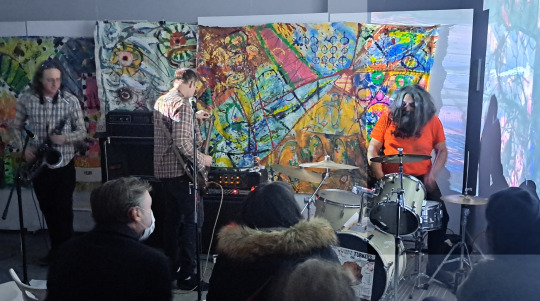
sKiN performs live in front of collaborative paintings from Stop, Drop, and Paint at Collins Studio Gallery. sKiN features Jason Dublanko on lead guitar and vocals, Tim Rechner on drums, and Mike Garth on saxophone. Photo provided by the artist.
Tell us about how collaborating has changed the direction of your work.
One of the music events at my gallery, we call “Shapes and ‘Scapes,” is where we team up musicians with painters to do an experimental electronic improv music and painting set. Usually, it’s a 20-minute set and it’s been a lot of fun. I’ve become a lot more experimental in my work and one reason is that I was involved in a “Shapes and ‘Scapes.” I completed a painting in the time frame whereas it usually takes me a month or so to make a landscape painting. I really wanted to see what I could do and really push myself to experiment, and I came up with something that I thought was interesting, and from there I’ve really pushed my painting. Another reason that my work is in the experimental stage is that during Covid, like many of us, there was some personal tragedy in my family, and because of that I decided to take a year off, a kind of sabbatical away from painting. It’s been almost a year now since I’ve come back to it.
What qualities overlap in being an artist, teacher, and gallery owner? How have you grown most in each role?
They overlap in that they all involve getting over fears, that’s for sure. With painting, looking deep inside of yourself and bringing that forward, that’s kind of a fearful act to do, to be really honest with yourself and bring something out that other people can see. When I first started out teaching, I was really fearful, I wanted my students to like me and didn’t want to waste their time. But then, I realized that with that fear, I was thinking of myself! I was able to turn it around and focus on each student. And as a gallery owner, again I keep on thinking, what can I give to people? Not, “oh I hope they like my gallery when they come in,” it’s like what can I give to them because they’ve come in here and maybe they want to learn something about art or maybe they’ve never been in an art gallery, and I try to make my space really kind of a community gallery. How I’ve grown in each role is just an evolution.
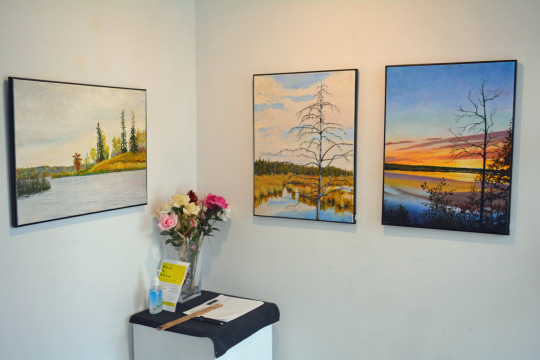
Earlier landscape paintings in oil by Jeff Collins (left to right): Islet Lake; Tamarack in Jasper; Lake Isle. Photo provided by the artist.
Tell us about what you’re currently working on or hoping to explore next.
For the nearly 30 years that I’ve been painting, I’ve been painting pretty traditional, great Canadian landscapes. For a while now I’ve wanted to push that in a new direction and with the “Shapes and ‘Scapes,” where I had 20 minutes in front of people to actually do it, I just got out of my way and made it happen. It took a long time for that 20 minutes to actually happen. I’m now exploring symbols that have meaning to me, and they may be symbols that other people use or have picked up on but they’re all symbols from my life that I’ve experienced. There’s also a spiritual aspect to my work. At one time it was all about me being present in this time, in this world, in this physical realm, so it was very important to me to paint actual places and get inspiration on location and take that back into the studio. Now it’s more like ok, that’s my physical body or physical being speaking to my spiritual being and now I feel like exploring symbols and what they mean to me and now it’s the other way around and my spiritual being is reacting to the physical world around me.
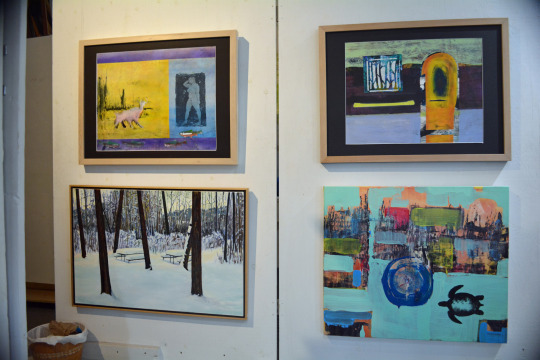
Recent abstracts (acrylic, oil, collage and gel transfer) and a winter landscape in oil by Jeff Collins. Photo provided by the artist.
What excites you most about the YEG arts scene right now?
After two years of not going out and seeing hardly anything, it all really excites me. I did a music show in my gallery last month where it was sold out, there were about 35 people in here — it’s a small gallery! The collaborative work that’s going on between different disciplines excites me, the festivals coming back and gaining traction, I love that. I’m really excited about what’s going on in the Alberta Avenue district, and Arts on the Ave is spearheading all of those things. The Kaleido Family Arts Festival and Deep Freeze: A Byzantine Winter Festival, for me, they are my favourite festivals in Edmonton because they’re so eclectic and you get to see it all in such a short period of time, it is a lot of fun. I’m really excited to see where things are going to go next, as well. I’ll quote the Tragically Hip, “bring on a brand-new renaissance.” It’s what I feel we’re going into here, a rebirth.
Want more YEG Arts Stories? We’ll be sharing them here and on social media using the hashtag #IamYegArts. Follow along! Click here to learn more about Jeff Collins and Collins Studio Gallery.
About Jeff Collins
Jeff Collins is an artist living in Edmonton, with nearly 30 years of studio practice. His formal studies were at Red Deer College (now known as Red Deer Polytechnic) and the University of Alberta. Jeff has received many awards and recognition for his artwork, notably the Telus Courage to Innovate in the Arts Award. In 2013/14 he served as the City of Edmonton’s inaugural Artist in Residence. His paintings have sold nationally and internationally. As an art educator and facilitator, he strives to connect people to art and creativity, encouraging skill-building, laughter and personal growth.
While he’s made a name for himself painting landscapes in oil for most of his career as an artist, he also loves to paint still-lifes, figures and almost anything else he sees and encounters in the natural world. Jeff is also fascinated with abstraction and using the properties of paint with the formal elements of painting and drawing to express emotions and captivate viewers.
In 2019, Jeff opened Collins Studio Gallery in the area of Alberta Avenue in Edmonton. It serves as his working studio, classroom where he teaches beginner and advanced oil painting, and exhibition space where emerging artists and curators are given an opportunity to show their work in front of a public audience.
2 notes
·
View notes
Text
“I Am YEG Arts” Series: Frances Whitford

It’s been said that grandparents are the voices of the past and the door to the future. For Frances Whitford, there are few truer sentiments. It’s why she describes her business, Beadwork & Bannock, as a creation of love and legacy to her grandparents and Métis culture. Lucky for us, that gratitude and knowledge are both gifts she’s eager to share with everyone. From passing down traditions to her children to championing the Indigenous Artists Market Collective (I.A.M), Frances looks forward to continuing to promote and support the perseverance of Indigenous art and culture in our city. Artist, advocate, granddaughter, and teacher—this week’s “I Am YEG Arts” story belongs to Frances Whitford.
Tell us about your connection to Edmonton and why you’ve made it your home.
I have a lot of family here. I’m from northeastern Alberta, just outside of Fort McMurray, so Edmonton was the closest major city and our go-to for everything—so we’ve always been connected to it. Even as a kid, we’d go to Lac Ste. Anne every summer, and then to K-Days because my grandmother had sisters and family here. From there we’d go around to Lac La Biche to the powwow before heading back home. So ever since I was a small child, I’ve spent a few weeks of every single summer here.
As an adult, what really drew me to Edmonton were the opportunities for my three children to grow. Being in a small community is great—the support you have is good, everyone knows your name, and your history, and all of those types of things—but sometimes that can put a real damper on personal growth when it comes to just wanting to spread your wings and be yourself. So all the genres of opportunities presented to them here were very alluring to all of us.
I also found the Indigenous Artists Market Collective (I.A.M) here, and that was amazing. I always say that when I found them, I found my tribe. As Lorrie Lawrence always says, it’s like a melting pot of Indigenous artists.
Tell us a bit about Beadwork & Bannock and how it came to be.
I grew up raised largely by my grandparents. They were very old-school, very Métis lifestyle, so I spent a lot of my youth on our family trapline, which my brother still runs with my cousin Jason. Despite being so immersed in my culture throughout my life, I didn’t realize then how blessed I was—not until 2011 when my grandmother passed away. She had developed Alzheimer’s around 2006, so it really felt like we lost her a lot sooner, but during that time was when I really began to realize that, wow, once she goes, all of this is gone.
My grandmother was an artisan herself and used what she earned to help supplement the family income. I loved watching her work, and a lot of time I’d get to play around sorting beads… but watching her create all these amazing things and seeing every part of the process—from trap to this beautiful pair of moccasins—was pretty cool. So when she passed away, I made my decision to allow myself to dream about making a living preserving my culture and being able to share it with others and teach my kids. Beadwork & Bannock was the answer. And there’s just so much good that has come from it. It is literally a legacy of love for my culture, my grandparents, and everything they’ve instilled in me. There were quite a few years of dreaming it up in my mind and wanting to be where I am now, but just knowing that this knowledge is for me to pass on to as many people as I can reach makes me very happy.

What inspires your design choices and the stories that your beading and clothing tell?
Again, it goes right back to my grandparents and realizing how much culture they preserved in me that I didn’t realize I carried until I was older. A lot of my beadwork designs are inspired by the work of my grandmother and from learning and exploring our Métis culture. As I did my genealogy, I realized just how far-reaching my Métis ancestry is when it comes to Canada and the United States. Because we were the landless people, we travelled so often that there are bits and pieces of my grandfathers’ and great grandfathers’ and great-great grandfathers’ families from Montana all the way through Saskatchewan and Manitoba. It’s pretty amazing to see that. So often I’ll look at all this beadwork from all over these places and feel such a connection to it. And at first, I don’t understand why until I realize it’s that ancestry that draws me in.
What’s one piece of advice you wish you’d had when starting out? And what’s something you knew instinctively that’s still serving you?
The advice I wish I’d had starting out is don’t limit yourself—don’t limit yourself to what you can and cannot do. When I first started, I felt very much that I was in this box and had to stick to mitts and moccasins and the traditional things my grandmother made. But as I’m evolving as an artist, I like to bring in contemporary elements and incorporate new-age thinking with the old—like repurposing fur coats. It’s conservation in itself. And a lot of what we do as trappers is conservation work. Some people have the misconception that we’re out there hauling out these furs and mass-producing and selling them. But, no. We’re actually doing a lot of environmental monitoring. So, for example, if there’s a species that’s low, we’re not going to harvest it. We’re going to refrain. Or if we’ve noticed a species is diseased, we’re submitting that all to the government to be tested to make sure that it’s not something invasive to these species.
The something I just knew from the get-go would probably have to be the importance of transferring knowledge. That was just the biggest driver for me after losing my grandmother and realizing that a lot of her knowledge was gone. Though I only have bits and pieces of it, I’m learning and growing on it every day, remembering more as I carry on. I also realized how important it is for us through truth and reconciliation to share that knowledge back and to give it to our future generations so that they can continue to grow on it and ground themselves with it—because that’s what it did for me.
I strongly believe that the knowledge and traditional practices I was given were meant for me to transfer, not to hold. Letting everyone know there is space for all of us to share and learn these things is something I’m very happy to do.
Tell us about someone who mentored you or helped set you on your path.
That would be my brother. I can really say that my brother has always been one of my biggest supporters and champions. When my grandmother passed away, the two of us sat down and had a conversation about my kids really needing to go to the trapline with him. They were all very small then, but I knew they needed to go with him alone because at that age Mom is everything—Mom, do this. Mom, do that. The trapline is a very wonderful and magical place, but it can also be very dangerous, so I knew they needed to build their relationship with him and the respect he required for them to safely enjoy trapline living—and to learn to grow their wings and be independent. So when my son was around 6 and my other daughter was 10 or 11, they went for their first weekend on the trapline with my brother. And that all started it. That’s when we both realized that if we didn’t transfer that knowledge, it’d be gone. From there, we started to talk about all the things that Grandma would make and decided to give it a try. The rest is history!
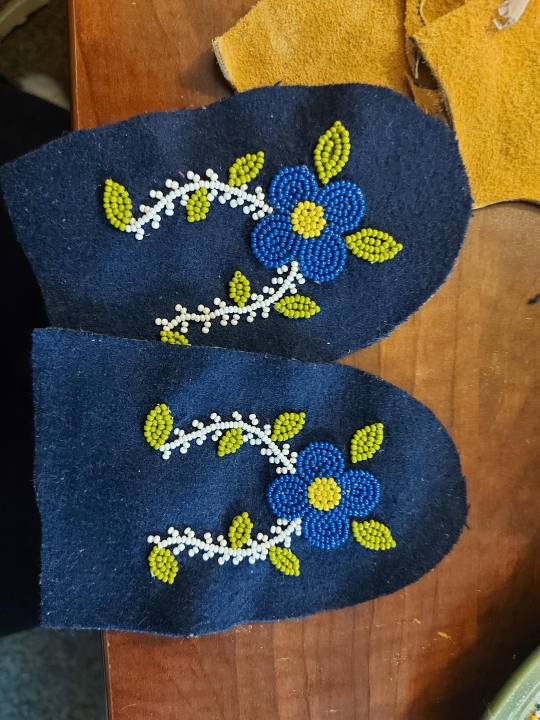

Who’s someone inspiring you right now?
Right now, I would probably say the artists with I.A.M. They have so many stories and inspire me so much with their resilience. There’s such an incredible amount of knowledge coming off each of these artists that stems from their families and their histories. And it’s just so inspiring to me to see our art coming back and being appreciated for what it is. The dedication each and every one of them shows to their craft is incredible. We even have one artist, Agnus Jones, who I believe is 89 years old. She does a lot of the similar work that I do, and the last time I saw her at the market I told her that, in my eyes, I am just an apprentice, she is a master, and that—one day—I hope to be as good as her.
Last year, you and your son designed a T-shirt for Orange Shirt Day. What was that experience like for you?
Normally, T-shirts are right out of my element, but I just felt called to tell this story (of our family’s journey of truth and reconciliation)—and to include my children. Part of our coming to knowledge of our past with residential school really shed light on understanding that we have our own story to tell. Knowing that the world is seeing the truth now, we needed to stand in our own truth. So I just really wanted my children to understand their history, as much as I can teach it, and as much as I can learn it myself to pass it on to them so they can understand why we are the way we are these days and which direction we need to move in. I needed a positive outlet to empower them to know that healing is possible, and necessary, and important for them to think about. That’s the real legacy I’d like to leave—that we need to move forward in a positive light, and that sometimes extracting a positive from a negative situation is the best way to grow and heal. That’s what I hope my T-shirts will do.
Tell us a bit about what you’re currently working on or hoping to explore next.
What I’m working on right now is focusing more on my beadwork detail. I just want to grow a little bit more, and explore a little bit more, and venture out into making new things, like satchel-style purses.
I’ve been exploring new mediums and playing around with caribou tufting, too. And it’s like, as soon as I understand my connection to these animals and these things, all of a sudden the creative comes in and I want to work with parts of them!
The kids and I are also working on more Every Child Matters T-shirts and collaborating on some other designs.
What do you want people to understand about the importance of buying Indigenous products from Indigenous artists?
It truly is a preservation of culture and of legacy. Our Indigenous art tells the story of our history, of our connectedness to other cultures and other places, and reminds us of the unity that we need to continue to share. I think it’s good to walk in your individual light and be proud of who you are and where you come from, but it’s also good to be proud of other cultures too—to raise them up and know that you stand in unity with them. So that’s what I’d like people to know: that when they purchase Indigenous art, they’re not only supporting an artist, they’re actually preserving a culture. And that’s an amazing thing.
Describe your perfect day in Edmonton. How do you spend it?
My perfect day in Edmonton would probably be spent exploring one of the many festivals or attractions that you literally find every weekend and everywhere you turn. Spending it with my kids, of course, because I love that.
You visit Edmonton 20 years from now. What do you hope has changed? What do you hope has stayed the same?
Well, I do hope that all the festivals and everything have stayed, but what I really hope to see is more reflection of the Indigenous presence that is here in the architecture and everywhere you turn. It’s starting to look like that now, but I’d really like it to be strongly visible. For example, the history behind the river lot that was here really needs to come to the surface—and in a good way. Because even though it’s a dark history, it’s a very positive place, and I love being there.
Want more YEG Arts Stories? We’ll be sharing them here all year and on social media using the hashtag #IamYegArts. Follow along! Click here to learn more about Frances Whitford, Beadwork & Bannock, and more.

About Frances Whitford
Frances Whitford is originally from Anzac, Alberta, but now calls Edmonton home. She was raised by her grandparents and grew up surrounded by Métis culture and craft, spending much time on the family trapline. Frances learned most of her craft from her grandmother, a Métis artisan, who made various pieces for the family and to sell in an effort to supplement the family’s income. Her grandfather was a trapper who would supply the furs and hides needed for her grandmother’s craft. Today, Frances’s brother has stepped into the role of trapper and supplies a large amount of the hides and furs that allow Frances to continue to learn and hone her skills.
Frances’s pieces, such as moccasins, mukluks, gauntlet mitts, and other Métis-oriented items, are made mainly of traditional and commercial-tanned moose hides, as well as beaver, fox, lynx, rabbit, and various other types of furs. Some of her Beadwork & Bannock pieces also include her beadwork.
As Treasurer of the Indigenous Artists Market Collective (I.A.M), Frances looks forward to continuing to promote, support, and participate in the advocacy and perseverance of Indigenous art and culture that she sees thriving in this city.
1 note
·
View note
Text
“I Am YEG Arts” Series: Trevor Duffy

If you grew up believing in tickle trunks, friendly giants, and a lovable frog who fell for a French-speaking piggy—lucky vous. Not only was it a great time for children’s television, it was a great time to be a dreamer, too. For some of us, like Trevor Duffy, that dreaming never stopped. Today he’s an accomplished puppeteer who’s created more than 100 puppets for productions including TV shows, music videos, web series, and more. His latest venture? The Imaginarium! A travelling puppet wagon that tours across Western Canada, delighting a new generation of dreamers with every show. Builder, creator, puppet show maker—this week’s “I Am YEG Arts” story belongs to Trevor Duffy.
Tell us about your connection to Edmonton.
I was born and raised in Edmonton, north side Castle Downs. Later in my twenties, I ventured to the south side, Whyte Ave, which is where I met a lot of other artists and creative people. With its vibrant music and art scene, the Whyte Ave community really inspired me to create more and gave me an opportunity to experience a wide range of artistic genres. I eventually settled on the east side of the city and work out of a quaint basement studio, with our backyard doubling as our rehearsal space.
How did you get your start as a puppet builder and puppeteer? What did that path look like?
I was always building something at a young age, experimenting with stop-motion animation or cutting up cushions to make puppet heads, but the big shift into really experimenting with puppets came from building black-light puppets for the Castle Downs Variety Show. After a few years of that, we decided to put on our own adult sketch variety show hosted by a puppet, Gabbo, borrowed from a Simpsons episode. We ran that show for a few years, which culminated with “the Death of Gabbo” on Halloween, where an executioner chopped off the puppet’s head, indefinitely ending that series.
Fast-forward, and I was lucky enough to land a job building and puppeteering for a network series called FELT UP. After working on that series, we decided to try our hand at developing our own, which we did. Now the puppet blood was flowing through my veins, and we needed a vessel to consistently produce puppet content. This is when The Imaginarium Puppet Theater was born—a puppet stage for travelling performances. We’ve been running this “theater” for the past six years across Western Canada, and during this time have been involved in building multiple puppets and puppeteering for local artists’ music videos, web series, TV pitches, and marketing campaigns.

What’s one piece of advice you wish you’d had when starting out? And what’s something you knew instinctively that’s still serving you?
Create your own opportunities. Put on your own shows, host your own events, shoot your own series. Whatever your medium is, do it, and do more of it. By creating your own opportunities, you’ll meet more people doing what you’re doing, creating more opportunities for yourself. This also gives you a chance to continually refine your craft.
What’s one of the biggest professional risks you’ve taken, and how did it influence where you are today?
It has to be building The Imaginarium, our travelling puppet wagon. It was the classic cart-before-the-horse story. We sold the idea before having built the puppet theater, or any of the puppets, or having even written a script. Originally, it was to be a variety-show format, but we opted to go for a storyline the further we got into it. As we shopped out our non-existent puppet show, we were very clear with everyone that we were still in the creation phase, but would have something together soon. Luckily enough, out of the hundred or so festivals, organizations, communities, rodeos, etc. that we reached out to, five or so liked the idea and booked us the following year. Here we are, six years later, still in our wagon, writing new shows each year and building a wider and wider audience.
What would you say is your greatest strength as a creative?
Having the desire to learn new things as I go and allowing myself to fail along the way. I have never been “formally” taught how to make a puppet. It has been years of trial and error, watching YouTube videos, and experimenting with different materials and fabrics. Every puppet is made from scratch from a pattern I create. Patience is key.
Tell us about the first thing you ever made that inspired your career path?
That would have to be Johnny 5, the first felt puppet I ever made. Although he was named after the robot in Short Circuit, he did not look like him. Johnny 5 was made from this blue fuzzy material with big dreadlocks and eyes that I got from the Dollar Store. You would attach the puppet to your body by slipping it onto your feet and using rods that were attached to its hands to move/dance around with it. This came about after a night with friends where we attached coat hangers to an old stuffed monkey and collectively tried to make it dance. I can tell you that when operating a puppet, a single brain controlling the movements is far more effective than three brains trying to do it.
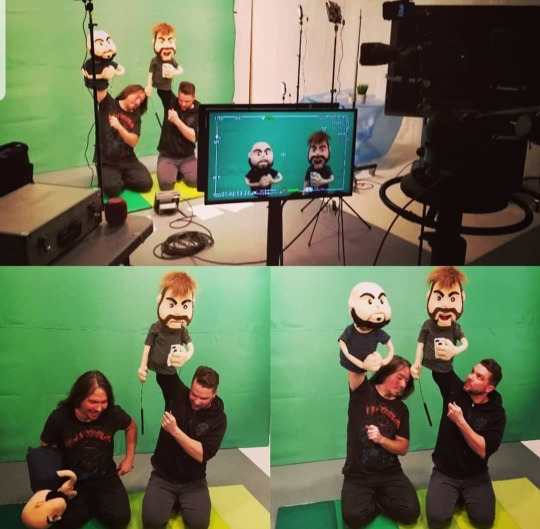
Who’s someone inspiring you right now?
I’m heavily inspired right now by visionary artists like Fabian Jimenez or Alex Grey. I am currently taking some of this inspiration and incorporating it into our first-ever adult show. I also love the whacky creativity of Becky Sloan and Joseph Pelling. They are the creators of Don’t Hug Me I’m Scared. A few other artists inspiring me are Ingrid Hansen, Chloe Ziner, and Jessica Gabriel, from BC. These women use extremely creative ways of incorporating storytelling with technology, making a much more immersive experience.
Tell us a little about what you’re currently working on or hoping to explore next.
Every year we like to write/create a new family show for The Imaginarium, so that is what we are currently working on. We will be bringing back some audience favourites and a new BIG surprise puppet. I have also been experimenting with some new technology for our first-ever adult show. Without giving too much away, we are working on pieces to visually enhance the performance and aide in the storytelling. We are all very excited about this next challenge.
When you think YEG arts, what are the first three things, people, or places that come to mind?
I think of the amazing illustrators and muralists in our city and the support that they’ve provided us over the years. I think about the venue owners and festival promoters who allow us to showcase and experiment with new creations. I think of our amazing culinary food scene that fills our bellies and fuels our creativity.
Great art has been and continues to be created here. YEG is an extremely supportive and vibrant arts city, and I’m very happy to have established my roots here.
Want more YEG Arts Stories? We’ll be sharing them here all year and on social media using the hashtag #IamYegArts. Follow along!
Click here to learn more about Trevor Duffy, The Imaginarium, and upcoming tour dates.
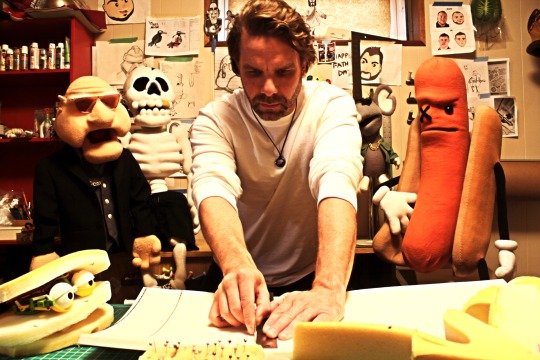
About Trevor Duffy
Trevor Duffy is a self-taught puppeteer and puppet builder from Edmonton, Alberta. Like many others, his passion for puppets came with watching shows like Fraggle Rock, The Muppet Show, Sesame Street, Harriot’s Magic Hats, The Friendly Giant, and Mr. Dressup. Trevor has handmade approximately 100 puppets since 2002 and puppeteered in productions such as web series, music videos, television shows, and marketing campaigns. His latest venture, established in 2016, is a travelling puppet wagon called The Imaginarium. This live-theater puppet show has performed all across this province, putting smiles on the faces of all audiences.
As computer generated animation and graphics threaten to take over in this digital world, Trevor’s goal is to ensure puppets/puppetry remains a viable art form, all the while shining a spotlight on Edmonton and Alberta.
2 notes
·
View notes
Text
“I Am YEG Arts” Series: Darrin Hagen
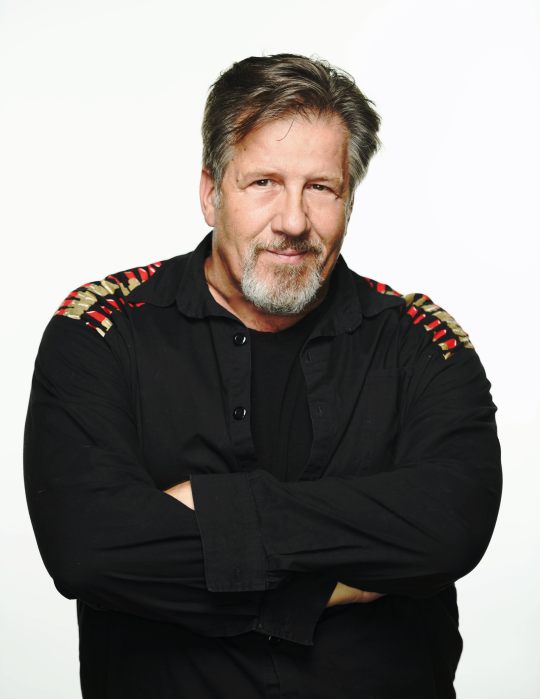
Speak less and listen more. It’s one heck of a resolution, and one Darrin Hagen made decades ago. His reason? You don’t learn much while you’re talking, and Hagen wants to learn. Consequentially, as pandemic fate would have it, he’s had more time than ever to work on that. While some of us were perfecting our sourdough, Hagen spent his hiatus taking comfort in his first love: music. He’s been writing about it, composing it, producing videos, and learning how to share it all digitally with the world. If that isn’t exciting enough, you can also look forward to the two plays he’s bringing to this years’ long-awaited Fringe Festival. Writer, performer, composer, and listener—this week’s “I Am YEG Arts” story belongs to Darrin Hagen.
What keeps you choosing Edmonton as your place to live and work?
I arrived in Edmonton four decades ago and never intended to stay, but good things keep happening to me here. Edmonton has always opened doors to experiences I never could have had anywhere else. It’s also a big anniversary year for me: 40 years living in Edmonton, 35 years since Guys In Disguise made its debut at the Fringe Festival, and 25 years since the publication of The Edmonton Queen.
Tell us about your journey as a storyteller of queer history and where you hope it takes you next.
I never try to predict or anticipate what’s next—and I think that’s the secret to moving forward. I didn’t write The Edmonton Queen 25 years ago to be political or to fulfill an agenda. I just wrote what I had experienced and what I was feeling. We are all the authorities in our own lived experience, and for whatever reason, I’ve lived through some pretty unique circumstances, and that’s given me a distinct outlook on the world around me.
I’m a history nerd and love research, so I’ll just keep digging and expanding my knowledge of what the Queer population of this province has endured. It’s important for the young Queers to understand the struggles of prior generations in order to fully appreciate and protect the privileges we now enjoy. And it’s important for the elder Queers to know that their pain and their efforts were not in vain.
I recently did a Zoom call with the gay seniors group and told stories of the many moments where I was in drag, dealing with the media that not only didn’t understand my gender fluidity, but didn’t even possess the vocabulary to describe it. The session was a blast and made me realize that I have many more stories to tell. I do feel a shift toward creating documentaries, though. Again—that’s not something I ever could have predicted—but it began to happen, and I am very open to it!
What’s your favourite part of the creative process?
I love that moment when you stop trying and just allow the art to happen—the moment where effort becomes effortless. It doesn’t always happen, but it’s so good when it does. After I’ve composed some music, my favourite part of that process is spending a few hours just listening. I also love that moment on stage when you’re in the last seconds of a play, and you can feel that it worked.
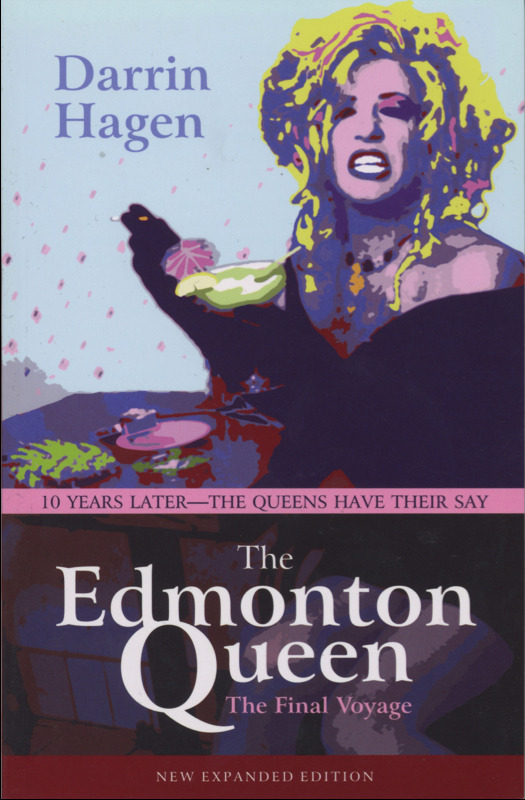
What does community mean to you, and where do you find it?
My answer to this has changed many, many times over the years. For a long time, it was in the club scene—the world of Flashback both saved and inspired me. Then it was the world of activism that was my foundation. Then for years it was the theatre scene. But I think through all of that, the people who enjoy my work and honour it by spending time with it are the community that means the most to me. My creative output is a conversation between them and I, and some have been on this journey with me since the days I was spewing Life cereal all over the Flashback stage in the early 80s. They’ve allowed me to grow, and struggle, and sometimes triumph.
The pandemic years have also shown me that my world has gotten very insular as I devote my time to solo creation. I think that’s a natural progression, as I morph into an artist that’s newly intrigued by digital dissemination.
What has surprised you most over the course of your writing career?
I don’t think I was ever really meant to be a writer, so everything I write is still a surprise. I’m surprised by some of the advances around Queer equality—most of the activists I knew couldn’t have predicted how quickly things could progress. I’m also surprised at how quickly language has changed in my lifetime. That kind of change used to take centuries, didn’t it?
It is said that to be an activist is to speak, and to be an advocate is to listen. You’re known for both. How is each reflected in your current work?
I made a New Year’s resolution decades ago to speak less and listen more. Anyone who knows me can tell you what a struggle that can be for someone as verbose as I. But I say it to myself every December 31: One doesn’t learn much while one is talking. I want to learn.
I have also spent decades interviewing people—first for Outlooks Magazine, then for HelpTV, then many, many interviews with Queer elders for the many Queer history projects I have been working on. It’s important to leave room for people to speak. As I get older, I get less and less interested in being the one speaking. When I do, I want it to be measured and thoughtful. That’s why I hate social media.
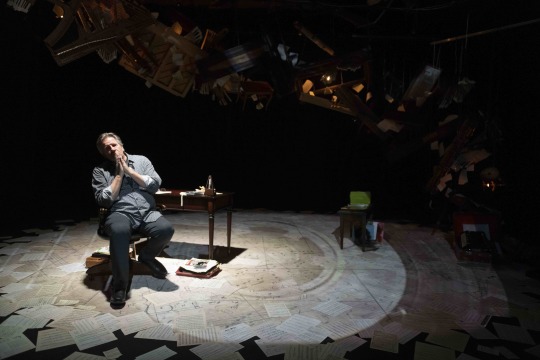
Metronome at Workshop West, directed by Heather Inglis.
What excites you most about the YEG arts scene right now?
I’m intrigued to see what new art and which new voices will emerge from the darkness of the pandemic. I had a very productive time composing music and learning how to edit video, and am about to start releasing music I made during the hiatus. I’ve already seen and heard some brilliant things. Society experienced something huge. The ripples will never stop.
Tell us about the importance of mentorship throughout your career and what it’s taught you.
Working with other writers makes me a better writer. I had some inspiring and generous minds that gave me early encouragement/advice. I feel a duty to pay that generosity forward.
The Queer community is in a situation now where a lack of mentors has created an impasse, or a gap, between generations. This has resulted in a population unaware of the struggles that came before. We should be building bridges between the present and the past. The more Queer history work I do, the more important that seems.
Describe your perfect day in Edmonton. How do you spend it?
A perfect Edmonton day is spent in my garden with a friend or two.
You visit Edmonton 20 years from now. What do you hope has changed? What do you hope has stayed the same?
In 20 years I will be 78. What I hope to see is a provincial government that has finally stopped fighting Queer equality. I also hope I see seniors’ homes for the Queer elders who changed the world for the rest of us. I hope the river valley is still natural and unspoiled. I hope the Edmonton Arts Council is still helping Edmonton artists contribute to the vibrancy of our city.
Want more YEG Arts Stories? We’ll be sharing them here all year and on social media using the hashtag #IamYegArts. Follow along!
Visit Darrin Hagen’s Vimeo to discover his digital catalogue of new music and art, and be sure to catch his upcoming Fringe 2022 plays: Crack In the Mirror (Varscona Theatre) and Pansy Cabaret (the Roxy).
About Darrin Hagen
Darrin Hagen is an award-winning playwright, author, composer, and Queer historian whose plays have been produced across Canada, in the US, and Europe. Since The Edmonton Queen (published by Brindle & Glass), he has created art that is a unique window into gender and history. During the pandemic, he turned his attention to creating video art and has done a deep dive into Queer history research, including many hours working with MacEwan’s Edmonton Queer History Project.
He has been Artistic Director of Guys In Disguise since 1987, has received 7 Sterling Awards for his work in Edmonton Theatre, and an AMPIA for his broadcasting work. Other plays include, Tornado Magnet, BitchSlap!, Witch Hunt at the Strand, Buddy, The Empress & The Prime Minister, Metronome, and the upcoming Pansy Cabaret.
Together with his collaborator, Trevor Schmidt, he has created a decade’s worth of hit Fringe comedies, including Flora & Fawna’s Field Trip, Flora & Fawna Have Beaver Fever, Dragula, Psychobabble, Prepare for the Worst, Puck Bunnies, Don’t Frown at the Gown, Klondykes, and the upcoming Fringe hit, Crack In The Mirror.
Hagen has been named one of the 25 Most Influential Alberta Artists in the Past 25 Years, as well as one of 100 Edmontonians of the Century.
2 notes
·
View notes
Text
“I Am YEG Arts” Series: Fern Facette
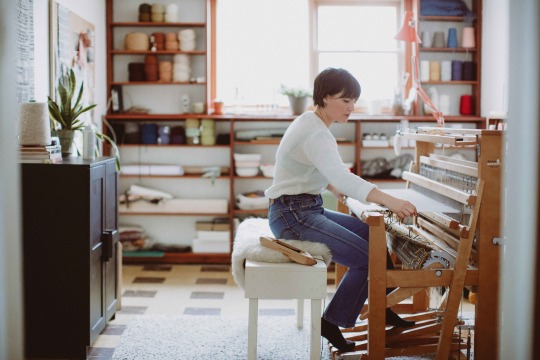
Creative work is work. Just ask Fern Facette, a stalwart advocate for the accessibility of textile arts and the opportunity to make a fair wage teaching them. An enormously talented artist herself, Facette knows first-hand the value of mentorship, opportunity, and community. In fact, they’re three of the reasons she founded Fern’s School of Textile Craft. Committed to putting a modern spin on traditional textiles, Facette and her team offer workshops including weaving, rug hooking, punch needle, sashiko, indigo, eco printing, and much, much more. Just as impressively on offer are all the things Facette knows are vital to community: inclusivity, compassion, and the long-standing tradition of sharing knowledge. This week’s “I Am YEG Arts” story belongs to Fern Facette.
Tell us about your connection to Edmonton and YEG arts.
I moved to Edmonton from LA (Leduc, Alberta ; ) ) during high school. In 2012, I signed up to sell weavings at the Royal Bison Art & Craft Fair, and that’s where I started connecting with Edmonton’s art community. Weaving is a very solitary practice, so it was exciting to be surrounded by other creatives.
What led you to fibre arts? And what was it about the community that made you feel like you belonged?
In high school I signed up for a crochet class and loved that meditative space you enter when deep into a project. That led to knitting, needle work and—eventually—weaving. Honestly, I mostly didn’t feel like I belonged in the fibre community! I was usually surrounded by women who were much older and pretty conservative. Only recently have I felt like I belonged, as the community has grown in size and inclusivity.
What’s the first thing you ever made that inspired your career path?
I couldn’t pin it to one specific object, there were so many! But that first Royal Bison really lit a fire in me. The pressure to fill a table with handmade items is good motivation!


Tell us about how Fern’s School of Craft came to be and what it brings to the YEG arts scene.
People repeatedly asked me if I taught weaving classes, so I decided to give it a try. I rented a small studio space and bought four used looms off Kijiji. Over five years, in true slow DIY Edmonton fashion, we grew to have 20 instructors offering various textile-based workshops. I think what Fern’s brings to the scene is an opportunity to make a fair wage from teaching and the opportunity to dive into an otherwise obscure craft.
What’s one thing you’d like to “un-teach” people about weaving or fabric arts in general?
I’d like people not to think of textiles as just something cute that your grandma does. Yes, that, but also know that making textiles is an ancient art that spans every culture across the planet—that textiles were once the most valuable commodity that shaped history on so many levels.
Tell us about someone who’s been a mentor to you.
I am lucky to have two mentors, Cec Caswell and Kathy Buse. Both have shown great generosity teaching me their respective crafts (rug hooking and weaving). Every craft has small tricks and techniques, they’ve given me so many of these, and I pass them on in every single workshop.

Who’s someone inspiring you right now?
Spray-paint graffiti muralist AJA Louden. He’s doing a tufting artist residency at Fern’s, and it’s been super inspiring to witness. He works hard and has fascinating storylines/themes he’s exploring. He came in not knowing a tonne about tufting, and after a month-and-a-half, the student became the teacher. Also very awesome how community outreach is a big part of his work.
What are you currently working on or hoping to explore next?
Over the past five years my family has been navigating a history of adoption, reunion, and discovery. I hope to work that into my textile practice.
What makes you hopeful these days?
The younger generation is what makes me hopeful these days. I hope they can continue to steer us away from rigid, binary thinking and towards a more compassionate and sustainable future.
You visit Edmonton 20 years from now. What do you hope has changed? What do you hope has stayed the same?
See above answer for what I hope has changed! What I hope has stayed the same is that grit and warmth that Edmontonians exude.
Want more YEG Arts Stories? We’ll be sharing them here all year and on social media using the hashtag #IamYegArts. Follow along! Click here to learn more about Fern Facette, Fern’s School of Textile Craft, upcoming workshops, and much more.
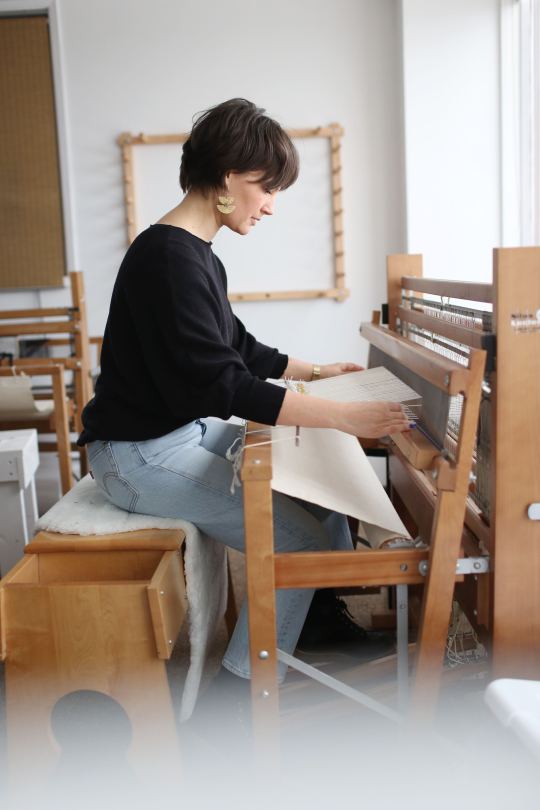
About Fern Facette
Jessica Fern Facette (Fern, she/her) is an Amiskwaciy Waskahikan (Edmonton) based fibre artist who has been weaving for nearly two decades. She is a passionately engaged artist who encourages others to discover textiles. She founded Fern’s School of Textile Craft in 2017, a place where fibre artists from across Canada meet to carry on the long tradition of sharing skills and knowledge. Fern is a stalwart advocate for the accessibility of textile arts and has created many opportunities for folks to explore textiles through years of volunteering, mentoring and—most recently—an in-studio textile residency.
Working within the confines of a four-shaft floor loom, Fern’s own weaving is an exploration of the infinite possibilities of the over/under grid-like woven structure. Boxes and lines of various sizes create repetitive designs, accompanied by use of colour and texture. Natural fibres dictate the objects’ function, from wool cushion to sturdy cotton/linen kitchen towels. Her woven objects are a nod to weavers past and a study on the human relationship to the long-lasting handmade object.
3 notes
·
View notes
Text
“I Am YEG Arts” Series: Raneece Buddan
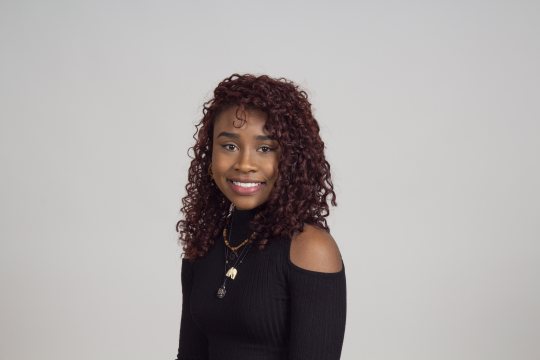
You don’t continually need to be making art to be an artist. There will be moments when you’ll be stuck, and that’s okay—you’re not losing the art in you. Those wise words belong to artist Raneece Buddan, who learned that truth soon after completing her BFA in Art and Design. As you’re about to discover, art and self-awareness go hand in hand for Buddan. In her work she focuses on her cultural identity, being of Afro and Indo-Caribbean ancestry, by using fabrics to symbolize the beautiful merging of both cultures, as well as the discomfort she felt around her hair and skin tone from childhood to her teenage years. Introspective, innovative, and inspired by process—This week’s “I Am YEG Arts” story belongs to Raneece Buddan.
Tell us about your connection to Edmonton and what keeps you living and working here.
My mother lived in Edmonton for a few years before being transferred to Fort McMurray for work. When I immigrated to Canada in 2015 from Jamaica, I spent my first year in Fort Mac before moving to Edmonton to attend the University of Alberta, after being accepted for their Fine Arts program. I have since lived here throughout my degree, and now two years after completion, I have stayed to grow my practice as an artist. Thankfully, Edmonton provides opportunities and funding for emerging artists that I have and will continue to make use of as I grow as an artist and build my CV.
What’s the first thing you ever made that inspired your artistic path? Did you know then that you’d unlocked something?
I was always a creative “artsy” child. The first thing I remember creating and being really proud of was a project for second grade, at age seven. It was a dollhouse made out of a cardboard box, covered in construction /cartridge paper, with added hand drawings. I remember being so proud of it because it was so neat and perfect—plus my teacher kept it years after. From then on, I continued making random stuff, and in high school, I finally had art classes from 7th–11th grade, which gave me access to artists (my teachers), new processes, and materials. This is where I first used clay for portraiture and began collaging and experimenting with textures in my paintings. Clay and collaging techniques are now major parts of my art.


Top: Blooming ancestry, 2019-2020, ceramic, fabric, plaster,21x12.5x19.5, photo supplied. Bottom: To Fit But To Stand Out, photo by Charles Cousins.
Tell us a bit about your process and use of material exploration.
My process in both my sculptural and painting practice has evolved into me finding my abstract figures within the material and being led by the material. I find figures within the grains of the wood (e.g. baltic birch plywood in my paintings), which I then cut out and intuitively add elements of the human figure, as well as fabric, both the real thing and painted. I strive to have my hand-painted fabric be as close to the real thing as possible. That means colour-matching and mimicking line weights and designs almost exactly.
In my sculptures, I follow the curve and natural grooves of the wood, and in my clay work, whatever abstract forms came from pounding the clay. Often times I’ll create small studies for my paintings and sculptures using a variety of materials to then translate into larger pieces.
Having recently completed your BFA in Art and Design, what’s your transition been like from student to working artist? What skill/wisdom have you leaned on most?
Initially, in the first year, I was incredibly burnt out because I went straight into an internship at Latitude 53 right after finishing my final year, which was from fall 2019 to summer 2020. I took no time off, which contributed to more burn out, so I wasn’t inspired to do art. I didn’t create any new work for almost a year. This was very hard, and I felt discouraged because I had been consistently making work throughout my degree, so I questioned whether or not I’d ever make art again. Eventually I had to make work because I’d received funding from the EAC with a report due. Through experimenting, I was able to get back into the rhythm of things for a couple of months, though I then stopped again for a few more months, however this time guilt-free. I realized then it was okay to not make work constantly. I also realized I knew nothing about being an artist outside of an academic setting, so it was unnecessary to be as hard on myself because I was still figuring it out and that “when it happens, it’ll happen. No need to force it.” I’ve been working at Latitude 53 for almost two years now, and I am happy with my work/art life balance.
What would you say are your greatest artistic sensibilities, and how do you nurture them?
I think I’m able to notice the small things—the microdetails. And I take satisfaction in (1.) noticing them and (2.) appreciating them by making them more visible by highlighting, transforming, or simply leaving them as-is; specifically for someone like myself who gets pleasure in seeing what has been overlooked to discover themselves.
What does community mean to you, and where do you find it?
I guess community means commonality, support, and being able to come together to enjoy and appreciate? I am happy to still have a small art community with some of my past classmates at the U of A. Even though we don’t share a studio space together anymore, we still make the effort to support one another online and in-person, whether that’s cheering each other on when we make something new or attending each other's exhibitions. I have also found a growing community with Black creatives in Edmonton, whom I connected with through the 5 Artists 1 Love exhibition. The first time was an Artist Battle I did in 2019.


Top: Within this Vessel, photo supplied. Bottom: Entwined, ceramic, wood fabric, 2019-2020, photo by Charles Cousins.
What’s something you’ve learned about yourself through your work?
I am very capable and am able to do anything once I put in the time and effort. I’m very proud of myself for that. I also learned I’m a perfectionist who always wants to keep things within the lines and very pristine—a gift and a curse.
Tell us a bit about what you’re currently working on or a technique you’re hoping to explore next.
Currently, I’m designing and printing my own fabric using screen printing and block printing. Fabric is the main component in my work, and I think it would be beneficial for me—and also a matter of authenticity—to know what certain symbols mean within the textile. Also to research and know exactly where my fabric is from and the process behind its creation. Through this, the process is a major part of the art piece as well.
I’m currently working at a small scale, but I’d like to work larger. I would also like to learn how to weave, as the textiles I’m researching are mostly weavings I’ve simplified, so it’d be interesting to actually make the weavings I’ve been researching and inspired by.
Describe your perfect day in Edmonton. How do you spend it?
I’m a homebody and an introvert, so I prefer to just spend as much time by myself in my own space. But if the weather is nice (a.k.a., it’s summer), sometimes I like to visit the park (e.g. the Paul Kane Park) and just lie there in the grass soaking up the sun and enjoying the fresh air, maybe watch the ducks be ducks. I enjoy just doing nothing—absolutely nothing. It’s a luxury and peak relaxation.
Want more YEG Arts Stories? We’ll be sharing them here all year and on social media using the hashtag #IamYegArts. Follow along! Click here to learn more about Raneece Buddan, her work and where to follow her on social media.

My Knots, fabric, synthetic hair, and oil paint on wood, resin,12x20, 2021, photo supplied.
About Raneece Buddan
Raneece Buddan is a Jamaican artist who moved to Alberta in 2015 and completed her BFA in Art and Design at the University of Alberta in 2020. In her work, she focuses on her cultural identity being of Afro and Indo-Caribbean ancestry, showing the beautiful merging of these cultures, as well as the discomfort she felt around her hair and skin tone from childhood to her teenage years. This is depicted by replacing her skin tone with fabrics meant to represent each culture and the use of synthetic hair. Her process is based on material exploration and finding figures within the material, the grains of the wood, and mounds of clay.
2 notes
·
View notes
Text
I Am YEG Arts: Andrew Ritchie

Photo by Mat Simpson
Andrew Ritchie is seemingly everywhere all at once in Edmonton's theatre scene. His versatility as a theatre artist, whether he is directing or performing onstage, has taken Andrew across the country, but it is his ability to “build it yourself” here in Edmonton that has always brought him back. As Artistic Director of Thou Art Here Theatre and co-founder of the Found Festival (under Common Ground Arts), that DIY mentality has allowed Andrew to tell relevant and exciting stories in unexpected places while focusing on how space and the role of the audience can be explored in any theatre show. Director, theatre maker, improviser, program coordinator, teacher, producer – this week’s I Am YEG Arts feature focuses on Andrew Ritchie.
Tell us about your connection to Edmonton and what keeps you living and working here.
I was born and raised in Edmonton or amiskwacîwâskahikan on Treaty 6, and I am a third-generation settler of Scottish, Irish, Welsh and Polish heritage. My family originally immigrated to Winnipeg and rural Alberta, but we've kind of been in Edmonton since the 1980s or the 1950s, depending on what side of the family. And I've had the privilege to work across the whole country, including spending many years in Toronto, ON, but also in Regina, SK. But I've always been pulled back to Edmonton because this is where my community is. A lot of my personal family actually doesn't live here anymore, so it definitely is a place where my chosen family is. It's where my closest friends are, it’s where I've just found community among the people that practice theatre here, and I think -- especially after living in Toronto, which is a much larger city than Edmonton, then also in Regina, which is a much smaller city than Edmonton -- Edmonton feels kind of like the perfect size in between, and I feel like I can have a large impact in the city with my art. And there's also an ability to be DIY and to build it yourself here, which is kind of why I want to keep living and working here. Currently I work as the Program Coordinator with Theatre Alberta, I am the Artistic Director of Thou Art Here Theatre, I'm an ensemble member with Rapid Fire Theatre, and I'm also a freelance theatre artist.
How did you get started in theatre? Was it always plan A?
No, it was definitely not plan A, or B, or C, or D. My parents loved attending theatre. They were always patrons of the arts, so I think I was very lucky as someone growing up in Edmonton that I got the opportunity to see shows at the Citadel or at the Mayfield Dinner Theatre, or at the University of Alberta. And we'd go to the Fringe sometimes, or to the Street Performers Festival. But I was never really an artsy kid. It wasn't really until high school where I came across a lunchtime improv club, and through that I heard about improv that happened at 11:00 o'clock at night off Whyte Ave, which was Rapid Fire Theatre. I'd never heard of something like that before, and it was the coolest thing. This was in 2003 and I just fell in love with theatre. From that I did the Bachelor of Arts in Drama at the U of A, which eventually led me to graduate with my degree in theatre, kind of focusing on directing but kind of getting a handle on a little bit of everything from the BA program. And right after graduating, in 2011 I was part of a group that founded Thou Art Here Theatre, and also, I was part of a group of individuals that created the Found Festival under Common Ground Arts, and those two things happened roughly around the same time. And I think those kind of solidified my ongoing career in theatre.
What was one of the biggest professional risks that you've taken and how did it influence where you are today?
This was a tough one to think about. I think the biggest show risk I've ever taken was that in 2019 I directed and produced a production of Mr. Burns: A Post Electric Play by Anne Washburn, who's an American playwright. And at the time, I wasn't living in Edmonton and that show was just so large in scale. I think the artistic risks we took to transform the Westbury Theatre into three different theatre spaces for that three-act play, and the design elements, and the original music we wrote for the show, and just all those different parts that came together for the piece were just such a huge risk and I think paid off in the art. It was definitely a very challenging process, and I can look back on that and it makes me think of the grandiose vision of that and the aesthetic of that show that is something that I'm interested in continuing to try to find. And I think for me as a director, I think scale or spectacle with people, just having a lot of artists involved, is kind of something that I'm always interested in working on large scale shows, even when I have small scale budget. So that was a very big risk that I think I took that continues to influence me.
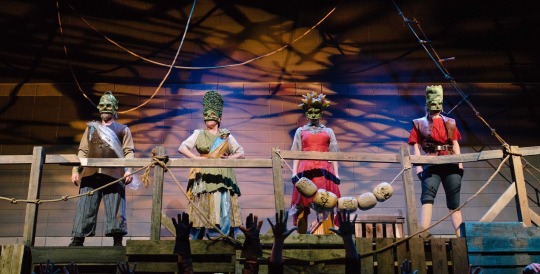
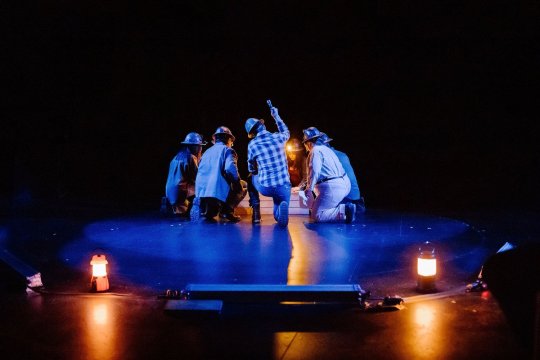
Top: Mr. Burns, a post-electric play by Anne Washburn. 2019. Directed by Andrew Ritchie, photography by BB Collective. Bottom: MINE by Ash Hicks. 2023. Directed by Andrew Ritchie, photography by Mat Simpson.
Tell us a bit about your role with Thou Art Here Theatre and what makes it special to you and the city.
Thou Art Here Theatre was co-founded in 2011 by myself and Neil Kuefler, who is a dear friend and a fellow graduate from the U of A. We both were emerging artists in the city and we, like many emerging artists, were very eager to work and we just weren't getting as many opportunities as we wanted. So, we decided to create our own opportunities and to produce shows in the spaces that we could get, which were free spaces, and I would say maybe sometimes “guerilla spaces” -- spaces that maybe you could ask for permission for, but we chose not to at that time. At that time, we were very interested in Shakespeare, being inspired by our professor David Barnett at the U of A. We were producing site specific, or “site sympathetic” Shakespeare shows that were engaging with the space.
That theatre company is so special to me. I still work with them today. I've come and gone from the company a little bit over the years, but really it represents friendship to me, like camaraderie. It's really hard to run a theatre company, but I think one of the reasons that Thou Art Here continues to exist, and a lot of the people that originally started it are still involved, is because we've always centered friendship at the forefront of it, and through that we’ve been able to take huge risks with our shows. We were able to tour a show to Calgary. We were able to collaborate with Freewill for the past eight years. And since 2011, the company has changed a lot. We are now a non-profit, and we just became a charity, and we also dropped the Shakespeare mandate so we are now less focused on the work of Shakespeare and more focused on how space and the role of the audience can be explored in any theatre show.
I think all theatre wants its audience to be engaged, of course, and I think when you break the rules that we understand about theatre, with how an audience may be is sitting, or they respond, or if they participate, I think it makes it much harder for the audience to disengage with the show. And I think it's more likely for it to be very memorable and hopefully an emotionally impactful experience.
Of all of your “site sympathetic” productions that you have created over the years, are there any particular standouts?
With Thou Art Here I think the one that we talked about the most in a certain nostalgic way is our production of Much Ado About Nothing by William Shakespeare, which we did three times. It had such a success to it, so three years in a row, and each year we kind of built upon it with the design of the show. We did it in 2014 and 2015 at the Rutherford Provincial Historic Site on the U of A campus, and then in 2016 we toured it down to the Lougheed National Historic Site in Calgary. And though many of the artists that were involved in the shows became close friends and it was a group of 10 actors, I found all three productions of those had ensemble. We found a beautiful sense of ensemble and I'm always trying to find that again.
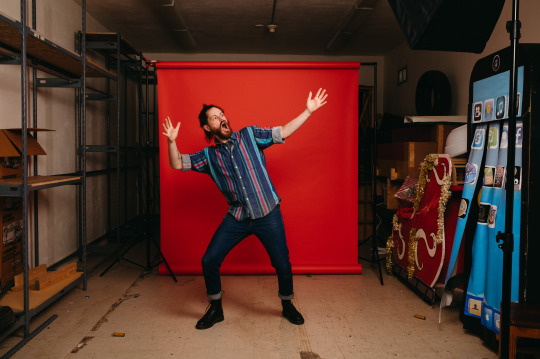
Photo by BB Collective
As a long-standing member of Rapid Fire Theatre, how does improv inform your creative process as a theatre creator?
I think it informs every part of it. I am constantly reminded of the rules of improv, or the tenants of improv. I am often working as a director or a leader in a space, and I think how I choose to have warmups in the space, how I approach rehearsal or teaching or directing, I want to embrace active listening, taking risks and that sense of play, which are all so important in improv. And I think continuing to act onstage and be in front of an audience can be super important for a director and makes them much more empathetic to the role of the actor and how an actor goes about the work that they do. So, I think it's all very tied together and I'm so very lucky to have performed as long as I have with Rapid Fire Theatre.
Who's someone inspiring you right now and why?
I recently had the fortune to travel to London, England and I saw a production of The Seagull by Anton Chekhov, directed by Jamie Lloyd who wouldn't be a household name, but this production starred famous Emilia Clarke. It wasn't Emilia Clarke that made this production inspire me -- she was great still -- but the overall design of the show and how it was they staged it, it really embraced simplicity. It took away any props or costumes. It was so contemporary to London and to the context there. It really just used people and theatricality. It was not naturalistic; it was using just chairs and bodies in space to create all the different environments. And I thought that was so refreshing and it was clearly not possible to do in film and I think that's such an inspiring thing to see in theatre.
And the other thing I just have to mention, are all my friends that are doing work in this city that inspire me. There's so many in the theatre community, but if I could rattle off a few, I am so inspired by my dear friends and their work: Geoffrey Simon Brown, Elena Eli Belyea, Gianna Vacirca, Oscar Derkx, Ainsley Hillyard, Lianna Makuch... there's so many. I'm inspired by my friends and community.
Tell us a little bit about what you're currently working on and what you're hoping to explore next.
So, I am currently developing a new solo show, my second show that I've ever created. It's called Cycle and it is all about urban biking and bike culture in Edmonton and in Canada. It's going to be exploring everyone's favourite two words: bike lanes. And I'd say it's hyper local, hyper political. It's also inspired by my time working as a bike food courier in Toronto and kind of talking about gig work culture and how biking can intersect with climate change and how we all have a right to move around our cities. So that's the show I’m currently working on.
The other thing I'm working on is that I'm about to have a second baby with my amazing, inspiring partner and wife Marlee in August. So that's kind of the next big life project.
If people are interested in learning more about any of the things I've talked about, you can go to https://thouartheretheatre.com/ or on all the socials, or I have a website andrewritchie.net and sometimes I post on Instagram, but not often.
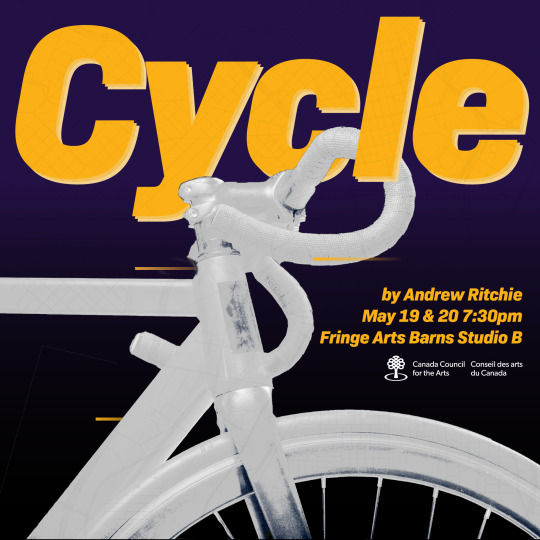
Promo for Cycle by Andrew Ritchie. Graphic Design by Tynan Boyd.
About Andrew Ritchie
Andrew Ritchie is a director, theatre maker, improviser, teacher, and producer born and raised on Treaty 6 territory in Amiskwaciwâskahikan (Edmonton). He has performed and directed across Turtle Island (North America) and his work has ranged from new work, contemporary, classical, improvisational, movement, mask, clown, bouffon, and immersive theatre.
He has a Master of Fine Arts in Directing & Creation from York University, a Bachelor of Arts in Drama & English with Distinction from the University of Alberta, and is a graduate of the Citadel/Banff Centre Professional Theatre Program.
Andrew is a co-founder and artistic director of Thou Art Here Theatre. He has performed improv across North America including being an ensemble member with Rapid Fire Theatre. Currently he is Program Coordinator with Theatre Alberta, an arts-service organization dedicated to the growth and development of the Albertan theatre community.
Previously he was the Sandbox Series Coordinator & Theatre School Director at Globe Theatre in Regina, SK from 2018-20. He is a co-founder of the Common Ground Arts Society's Found Festival, Edmonton's multi-disciplinary found space arts festival and was festival director from 2014-2015. He has ran two other indie theatre companies: Rock Steady Productions (2010-2012) & You Are Here Theatre (2016-2020).
1 note
·
View note
Text
“I Am YEG Arts” Series: Steve Pirot
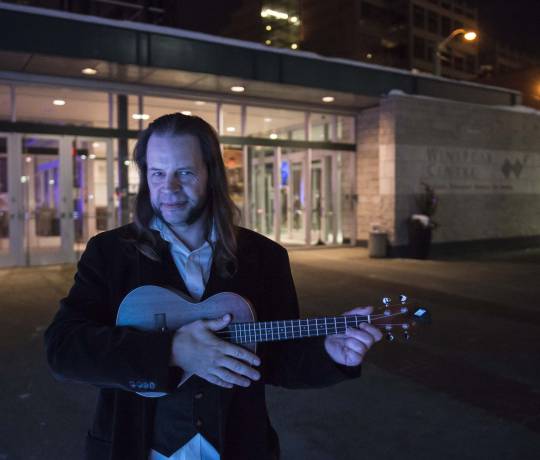
Photo by Marc Chalifoux
Grow where you’re planted. Steve Pirot certainly did—and has never stopped. That desire to express his growth and curiosity is something he champions not only for himself but others. iHuman Studios is where he accomplishes both, serving the needs of young and emerging artists, while strengthening a community to which he belongs. But that’s not the only place Pirot’s mark can be found. As an actor, director, and writer, he’s worked with most of Edmonton’s theatre companies… in the city that made him an artist… and the only place he’d ever call home.
Artist, absurdist, and rhyme-loving dreamer—this week’s “I Am YEG Arts” story belongs to Steve Pirot.
Tell us about your connection to Edmonton and why you’ve made it your home.
Edmonton is my beat because Edmonton made me. If I had been raised in a different city I would be made differently, but I was born here. And then—after that—I grew up here, and then—after that—I kept on growing up here, and then—after that—my rhythms had become so tuned to this place that any time I’ve been presented with the idea of relocation, I rediscover that I don’t want to make my home anywhere else. So here I am. What I didn’t know when I was 20, but can see clearly now, is that Edmonton in the 80s was disproportionately fertile ground for a young person curious about artistic experiences. That is kind of how being born here made me into an artist. It could have made me into something else, but I don’t think another city would have made me into an artist.
When you were first starting out, what was it about the arts that made you feel like you might belong there?
I don’t think I ever asked “where do I belong?” but rather “where can I serve?” (Maybe those were the same thing?).
In my early 20s, after a childhood obsessed with athletics, I kind of stumbled into theatre knowing almost nothing about it, and many people wondered what I was doing there. Mostly, “there” was the U of A Drama Department, and “when” was the late 80s when that department was producing lots of shows but was comparatively light on enrolment. So, there was always something for an undergrad to do, and I took advantage of that. I also took advantage of the non-profit arts organizations that needed volunteers, and I actually received more than I gave. For example: I was meeting professional artists, learning how organizations were structured, how to splice tape, how to coil cable, how to set up a box office, how to patch lights, how to print posters, how to distribute posters, how to get a keg, how to tap a keg, and who to talk to to get the real answers. I was peeking behind the curtain and building the beginning of my network. I didn’t know I was doing that, but that is what I was doing. Somewhere along that path came the sense that I belonged there because people stopped asking what I was doing there.
Tell us about someone who mentored you or helped set you on your path.
Just one? If I had to select one above all others it would be Tom Peacocke (leader, founder, major-general of the U of A’s BFA Acting program), but... that’s not unique only to my personal path. Tom trained a small army of theatre artists over the years, of which I was one of many beneficiaries. He was certainly the most important role model for me when it comes to the part of my path that is dedicated to serving the needs of young and emerging artists.
That said, I think I’d rather nominate one of the people who didn’t encourage me as my “someone who set me on my path.” I won’t name them. I won’t even say they were wrong, but having someone doubt my potential was even more motivating than confirming someone’s confidence. My path became more personalized and focused when I had something to prove.
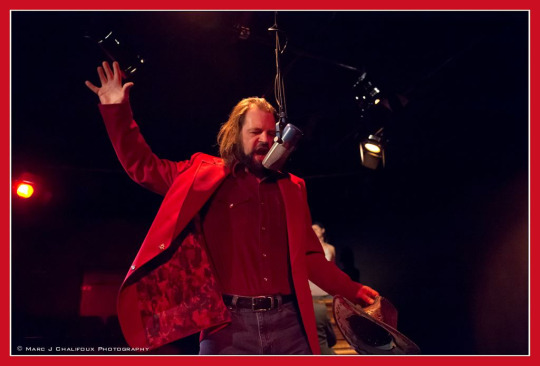
Apocalypse Prairie, photo by Marc Chalifoux
What themes are you drawn to as a storyteller?
To Dream is my favourite theme is to Dream, because first of all, rhyming: and then (b) the things that happen in our Dreams are not limited by the laws of (i) Time, (ii) Space, and (iii) Gravity... or Grammar for that matter, and fifthly because the Wild Rumpus that happens in my Dreams puts my Waking Life shenanigans to shame, and lastly because Dreams are something I don’t need to have to explain to someone because Dreams are a Universal Machine and first of all Dreams are Dreams, and Associative Logic is my favourite kind of logic and have you ever heard of a Tangent before or even a RUN ON SENTENCE full of irrational Nonsense because as an Absurdist I just have to say that have you ever noticed that when we gather people into a theatre to be an audience how often we ask them to sit still and sit quietly in comfy chairs and then we turn out the lights and tell them stories kind of like we’re asking them to fall asleep together for a little while but for a little once upon a time watch a story, a Bedtime Story, together kind of like almost like sort of like a Dream a Collective Dream and like maybe that’s a working definition of what culture is, a Collective Dream, Maybe Culture Is Our Collective Dream? Dreams.
Tell us a little about your role with iHuman Youth Society and what makes it special to you and the city.
iHuman Studios is both an Edmonton-based multi-disciplinary studio system and the artist collective of 12-to-24-year-olds who inhabit those spaces. Our mission is to transform trauma-informed experiences into experiences of purpose, self-worth, identity, and belonging. The primary tool we use to accomplish that goal is the arts.
I’ve been associated indirectly with iHuman since 2001 and have been employed as Artistic Director since 2016. My primary roles are the day-to-day supervision of the studio system and to represent our artists’ interests when they have opportunities to express themselves in the broader community. Working at iHuman fulfills a personal need to believe I’m using my skills in service of something more important than myself. I think iHuman is something Edmontonians should value because it is evidence that as a city we are aware that the playing field is uneven, and that we care to do something about it.
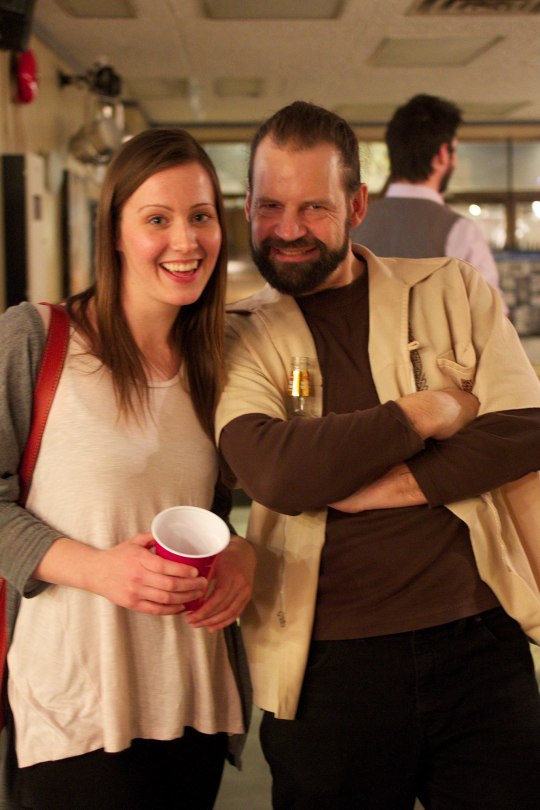
Alyson Dicey and Steve Pirot, photo by Majka Czprynski.
What does community mean to you, and where do you find it?
Community is a... system... or a network... a web... a lattice... a matrix? An ecosystem! Community is an ecosystem of... interlaced and interdependent individual entities that are... that are. They just are. They are interlaced and interdependent and... probably have common interests, but not necessarily common agreement on how to pursue those interests. And I don’t think that’s the type of answer the question was hoping for, but... it’s kind of like asking what oxygen means to me. I don’t know what it means to me, but I know that it’s all around me, andthat I take it for granted, and that if I don’t have it I’ll die. And that if I try to access it and it’s not there... then something has catastrophically gone wrong.
Tell us about a lesson you’ve had to learn more than once.
Nobody can read my mind.
Who’s someone inspiring you right now?
In Dylan Thomas’s A Child’s Christmas In Wales, the narrator speaks of “the distant speaking of the voices I sometimes hear a moment before sleep,” and that is what inspires me these days. Voices that are too far away from me to understand what they are saying, but clear enough that I can dig how they are saying it. I’m inspired more by the sounds of voices, rather than WHAT the voices have to say. I dig the music of the voices. I am inspired by the distant speaking of voices until those human voices wake me... and also by Kendrick Lamar.
When you think YEG arts, what are the first three things, people, or places that come to mind?
I’d usually say the Edmonton Arts Council as my #1, but given that this is an EAC platform, I’ll shake it up.
I’m putting The Fringe Festival as my #1 because it speaks to Edmonton as a festival city, to Edmonton’s place in the international arts scene, to how we are looked at as a leader in a North American context, to how arts activity can transform the identity of a neighbourhood, and it’s been a place of nascence for so many of the artists, companies, and audiences that inform the rest of the performing arts scene in Edmonton.
My #2 is the University of Alberta’s Faculty of Extension because of the groundwork dating back to the 1920s for a province-wide program of arts-and-culture education, the creation of the CKUA network, The Banff Centre For The Arts, Studio Theatre, all of the fine arts programs at the University of Alberta, and more. Remove that history of activity, and Edmonton doesn’t have the foundation upon which so much has been built in the past century.
And my #3 is The Artery. Yes, its legacy continues with The Aviary, but The Artery is more important in my mind because it got torn down. It is, therefore, part of history now and needs to be remembered as one of those dirty and dark, low-tech spaces that we will always need for an independent scene to thrive. As my #3, it stands for scores of spaces in Edmonton that had their moment: The Haven, The Living Room Play House, the Dance Factory, Studio E, Chess House, The Multi-Purpose Rumpus Room, Spazio Performativo, The Ortona Armoury, Wunderbar, and all those other spaces that I have forgotten about or have never heard of.
Describe your perfect day in Edmonton. How do you spend it?
A typical satisfying day in Edmonton involves: dropping off my skates for sharpening at Totem Outfitters, then buying a sandwich at Farrow, a coffee at Transcend, a book (or five) at Glass, a pint of ice cream at Kind, then back to Totem to pick up my skates for a late-night skate.
Want more YEG Arts Stories? We’ll be sharing them here all year and on social media using the hashtag #IamYegArts. Follow along! Click here to learn more about iHuman Youth Society.

Steve on top of the old Roxy Theatre, photo by Jill Connell.
About Steve Pirot
Steve Pirot (a.k.a., Unkl Stiv) is an Edmonton-based artist and administrator who has been the Artistic Director of iHuman Studios since 2016. Prior to that he was the Festival Director of Nextfest for 16 years, an Artistic Producer with Azimuth Theatre, an Artistic Associate of The Edgewise Ensemble, and a cast-member/writer of The 11:02 Show. As an actor, director, and writer he has worked with most of Edmonton’s theatre companies and has also presented work in Vancouver, Calgary, Winnipeg, Ottawa, and London, UK. He holds both a B.A. Drama and a B.F.A. Acting from the University of Alberta, has been nominated for a Sterling Award on six occasions, and regularly contributes to arts-based juries and forums. He’s written some plays, he’s acted in a few short films, and has a handful of credits for video game voice-overs. He has been participating in spoken-word open mics for over a decade and is currently working on a one-man show based on spoken-word forms, which will be presented at the 2023 Edmonton Fringe.
0 notes
Text
“I am YEG Arts” Series: Jen Mesch
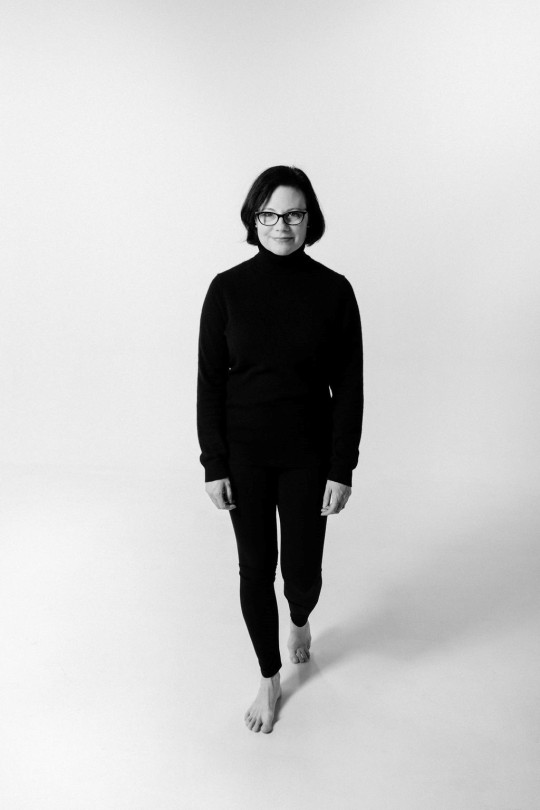
Photo by Aspen Zettel, 2021.
Contemporary dancer and choreographer Jen Mesch’s creativity is seemingly boundless. She doesn’t shy away from new adventures and challenges, whether it’s a fascinating new collaboration with an experimental musician or mastering a new artform (in recent years she’s added film to her repertoire). She’s a multi-disciplinary artist in the broadest sense and embraces cross-training not only in dance, but in other schools of thought such as philosophy and science, and by staying in tune with her community.
This week on the YEG Arts blog, we catch up with the multi-talented artist, Jen Mesch.
Tell us about your connection to Edmonton and what keeps you living and working here.
I moved to Edmonton a little over 13 years ago from New Jersey. My husband who's a composer got a job working at the University of Alberta and I started working here as a healthcare worker. I guess my sort of “Edmonton origin story” in dance is that I looked up what kinds of things were happening and found Mile Zero Dance. I saw this photograph of Gerry Morita [Mile Zero Dance’s Artistic Director] in a fake fur coat in front of a barn with these wild sunglasses, drinking a cup of tea, doing a little bit of a dance pose – and I knew I was going to be fine in Edmonton! Mile Zero has really been a great place for me, I have performed there as an independent choreographer, and since the beginning, I really was welcomed with open arms into that contemporary community and just this year I decided to be on the Board. It has been kind of a home base for me as an independent choreographer.
As a multi-disciplinary artist, is there a common thread you bring to all of your storytelling? Are there themes you find yourself revisiting time and time again?
I think people look at dance and see a story – that's a normal thing for humans to do – to look for meaning or a story, but [as dancers] we're not actually trained in storytelling. I think that's a specific skill, it's literary. People often don't ask the same thing of music, and dance is sort of uniquely situated in that we're connected very strongly to music. Obviously, we also have a strong connection with theatre and performance art. But we're also completely different from all of them. I definitely try to steer away from storytelling and I think that's hard in a big theatre town (it's a big literary and music town too.) I think it's hard for people outside of the dance community to find their way into non-narrative work. But the common themes for me are that I tend to work as a soloist as an independent choreographer. I'm pretty reclusive in my daily life so I do a lot of solo work and a lot of the themes involve solitude, organic sorts of landscapes and in the case of my current work Go Where Light Is, I guess outer space and the universe are included in an organic landscape.
What's one of the biggest professional risks you've taken, and how did it influence where you are today?
The biggest professional risk I ever took was deciding to become a dancer at age 22 because I didn't study dance as a child. [As a young adult] I did start taking dance classes, and then I went on to major in engineering. There was a talent show at my engineering university and I entered one of my little dance pieces and won first place. The $50 prize meant I could buy my chemical engineering textbook; I was so happy and relieved. Eventually, I dropped out of engineering and told my parents I wanted to be a dancer, which was, I think pretty wild of me to do. I mean, I'd had just twice-a-week classes at my community college in modern dance. I had come back from dropping out of engineering school and I asked my dance teacher what I needed to do. She said, Take as much ballet as you possibly can, and take jazz and modern – take everything. So I did. I took all the money from my minimum wage job and took every dance class that I could take. I was in classes five or six days a week. I don't see myself as a super high-level dancer at this point in my life, but I can't believe how much I've done and have been able to do. So, I guess that my advice to other people is to try. You don't know unless you do and put everything into it. It could have gone nowhere for me. I could have changed my mind, but here I am.
What's one piece of advice you wish that you had received when you were starting out in dance?
I was an adult when I started studying dance so it's a bit different than when you started out as a kid. I started with some already firm ideas of who I was and what I wanted dance to be for myself, but I think one piece of advice I wish I had (which I do anyway) is the notion of cross-training. Both physically and in terms of genres or disciplines, I think it's really important that people learn about other artforms, learn about other schools of thinking, about philosophy, and the sciences. All of those things make us more rounded human beings and should inform our practices as artists.
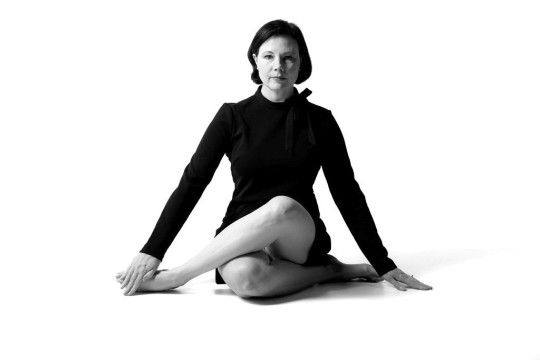
Photo by Aspen Zettel, 2021.
Tell us a little bit about the unique characteristics and challenges of dance in contrast with other art disciplines. What do you wish people better understood about dance?
Well, I think it's changing a little bit, but there are some biases against dance (at least in North America) that dance is sort of inherently female and that it's inherently recreational. So, I think it gets discounted. People understand that you can be a recreational photographer; you can be a professional photographer. I think people do understand that there are ballet dancers that are very highly trained, but it seems so unattainable for most people. That is a big wall that I think we're all trying to figure out how to break down a little bit – these hierarchies in dance.
Another disadvantage is that it costs a lot of money to put it on; it's very labor intensive; and it's a very personnel intensive art form. Dance is seen as being mostly for girls and women, even at young ages. It's very hard to find role models for boys who want to dance and yet it's often men who then become the major choreographers and the major directors of dance companies. Women are trying to find their voice at a time when we're also stepping aside to make more room for more kinds of people and more kinds of dancers. I think that's a challenge for everyone in the arts – to make more room.
Another significant problem for Edmonton and anywhere really, is that compared to other art forms, there are fewer dance programs at the post-secondary level. Edmonton currently has nothing like that as opposed to very fully realized theatre and music departments. It’s something that the dance community is trying to address. At the same time as we're trying to increase scholarships and increase awareness of dance, we're also trying to increase awareness of each other's dance forms and dance communities.
Tell us about your most recent dance project, Go Where Light Is.
Go Where Light Is has been a really exciting and challenging project. Because I normally work as a soloist, the larger-scale things that I've done have been with improv structures that have been quite loose. Like I construct a general timbre of the piece and they're usually people spread out over large areas so that people sort of come upon little things happening in different places in an area. With this one, I don't want to say this is my pandemic piece, but I did really miss dancing with everybody. I just had it in my heart, I wanted to do something really big with lots of people in it. I also had these really strong eerie feelings of the universe really not just being something out there in outer space or something that requires technology to perceive. That it's really just around us all of the time. And all these distances of course are relative. And even during the day, it's not something that happens at night, where we can see stars. The stars are just always there. And I just started thinking about how strange the world is as we've created these structures and systems around us. I started thinking more and more about the uniqueness of the human animal and the context of the universe without all of these constructs around us. So that's kind of where I started. There are a lot of themes that come through in the piece, the music steers a lot of it. The piece was written by my husband Scott Smallwood and his collaborative partner Stephan Moore.
Tell us more about your filmmaking.
In 2016-17, I was the artist in residence at Harcourt House. The residency is meant to support the work of an artist as they advance or emerge into a new area of their work. I was in my late 40s by then and I was dealing with lots of injuries and thinking a lot about what I wanted to be doing and about the online presence of dance. And I started thinking I would like to learn how to do dance for film and during the residency. I started taking film classes at the University of Alberta and FAVA. I made some little films in those classes, and they became part of the exhibition at the end of my residency, and then I found out that you could submit online to film festivals, so I got into a bunch of film festivals which was weird and fun. I felt a little bit upset because I'd been making films for, like, not even a year and I was getting awards for filmmaking. You could just never do that with dance! It’s said it takes ten years to make a dancer. I told my teacher that and he said, “Well it's different for you because you're already an artist.” I suppose that's kind of true, I already have strong compositional ideas and content ideas. It is a very different medium. It turns out I really love editing and it goes back to this whole thing of kind of being a person of solitude.
Can you tell us about a hidden gem in Edmonton’s dance scene that you think more people should know about?
Mile Zero Dance is opening up a new space in the next little while in the Ritchie neighborhood and I'm really excited to see how that's going to affect everything. Both in terms of having a more solid and secure location for themselves and what it's going to bring to dance. That's probably the thing I'm most excited about.
Want more YEG Arts Stories? We’ll be sharing them here and on social media using the hashtag #IamYegArts. Follow along! Click here to learn more about Jen Mesch.
Listen to Jen Mesch tell her story on CBC Radio’s Radio Active show! Aired March 23, 2023.

Photo by Aspen Zettel, 2021.
About Jen Mesch
To say that dancer/choreographer Jen Mesch inhabits any performance she gives is an understatement. Described as enigmatic, unusually perceptive and artistically fearless, Mesch’s wide variety of interests often lead her to unique collaborations in unexpected places.
Mesch has created over 200 works for dance performances, film, and experimental theatre in the US and Canada. She has performed with Cindy Baker, Dawn Cargiulo Berman (Momix), Penny Hutchinson (Mark Morris Dance Group), Jack Magai (Troy Chainsaw Ensemble), Linda Mannheim (Martha Graham Dance Company), Jennifer Monson (Birdbrain Dance), Gerry Morita (Mile Zero Dance), Susan Tenney (Jane Erdman Dance) and Kimberly Young (a canary torsi). For over a decade, Mesch has worked primarily with experimental musicians and has performed with Roger Admiral, Nico Arnáez, Allison Balcetis, Stephan Moore, Will Northlich-Redmond, Scott Smallwood, and Nate Wooley. She was the 2016-2017 Artist in Residence at Harcourt House which culminated in a two month dance, film, and visual art installation in fall 2017. Her film Hard White Spring received the award for Outstanding Experimental Film or Video at FAVA Fest and it was a semi-finalist in Cinema d’iDEA festival in Rome. Her first film, Soft Red Winter was screened at the Venice Short Film Festival. Mesch also teaches dance improvisation and technique, and her writings on dance have appeared in The Dance Current (Canada) and on her own Dance Conspiracy blog.
1 note
·
View note
Text
“I am YEG Arts” Series: Giselle General

Recent artworks by Giselle General. Photo provided by the artist.
As a community advocate, Giselle General knows very well the good we can achieve in the world when we come together. When you pair Giselle's compassion and drive with her creativity, you get an emerging artist with a lot to contribute. Her community service includes sitting on five volunteer boards. Online she is dedicated to helping others as a connector and activist. She recently left her steady gig in the non-profit sector to focus on writing creative non-fiction and visual art. Not one to be idle, she’s making the most of this time to write her memoir, a coming-of-age story of a Filipina girl up until her arrival in Canada as a teenager.
This week on the YEG Arts blog we get to know the storyteller and community builder, Giselle General.
Tell us about your connection to Edmonton and why you've made it your home.
I identify as a Filipino-Canadian and I have been here for half my life. I had a similar experience of a lot of immigrant teenagers. We don't really choose where in Canada we're going to land. I came to Edmonton in 2008 but I first lived in St. Catharines, Ontario for a year. Where you are planted you try your best to build roots, right? I did all the young adult stuff, so to speak. I went to university, I had jobs, internships, and made friends. I met and fell in love with a born-and-raised Edmontonian. That is a significant factor in making Edmonton my permanent home base. A few years after I immigrated, my teenage brother also came. That entire process of helping a fellow teenager settle in helped me experience Edmonton more deeply. That impacts you profoundly. It’s those different experiences that made Edmonton my true home.
What drew you to writing and making art? Were they a natural fit for you or something that you grew into over time?
You cannot be a top student in school in the Philippines if you don't have good grades in writing, both in English and the Filipino language classes. It's a necessary skill, but for me, it was also an interest. I got into student journalism, and it was a great part of my childhood and teenage years. Eventually I discovered that there's an ethnic newspaper [Alberta Filipino Journal] here in Edmonton, where I volunteered despite not having a degree in journalism. Writing as a personal expression — that became more of a thing during my university years and afterwards.
For visual art, I never imagined doing that at all because it was my parents that had the beautiful handwriting. My mother was creative, and I thought I inherited none of that. I was quite young when they died, so it's not like I had the chance to learn from them either. Here in Edmonton, it started more as a hobby. I made our home decor, and my husband really encouraged and nurtured my visual expression. In all my artistic endeavours I like to call him “the wind beneath my wings.”
As a storyteller what narrative or inspiration do you find yourself returning to?
I admit I find these questions awkward; they tap into the knowledge of what I would describe as literary arts experts and I’m not one of those. I have a Bachelor of Commerce degree and I managed to squeeze in a few literature electives. What resonates with me is far as a narrative — and even the content — is just the simple, sincere and compelling way that real people share their stories, knowledge and experiences. It’s probably why primarily my work is non-fictional. I don’t need to make stuff up because people’s real lives have more than enough material to make something creative and inspirational. That’s how I think of my storytelling, writing style and what resonates with me.
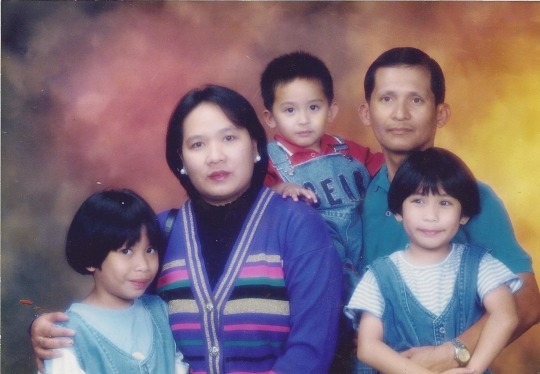
The last portrait of Giselle's family, taken on the day of their accident (Giselle is the child on the right, held by her father.) Photo provided by the artist.
Tell us about what you're currently working on or hope to create next.
I am immensely privileged that my husband and I managed to modify our financial circumstances so that I am not as pressured to find employment for the past seven months. I had unprecedented time and capacity, which is overwhelming. My current project is the memoir that I'm writing — my first literary project of this scale. It's a coming-of-age memoir from the day my parents and sister died to the day when I landed in Canada in August 2007. My plan is to have an artistically compelling work that will take readers on an adventure of a Filipina girl’s story growing up. And thanks to different resources that I managed to access in the past few months, the manuscript is developing well. I hope that people get to read it in the near future. The road to publication and promotion is exciting and I hope we get there soon! It will be a new experience to work with editors while finding a way to make a living – since my savings account is not unlimited.

A stack of primary source materials for Giselle's memoir. Photo provided by the artist.
Tell us about someone who has mentored you or helped set you on your path.
My husband is the first person who showed appreciation for a visual piece of art I made. That helped me integrate creative expression regularly into my life. Aside from that, I’m grateful for the different mentors and organizations I’ve encountered. I try reminding myself that I am worth it and that I can apply for these kinds of things. The Writers’ Guild of Alberta has a group called the Horizon Writers Circle for underrepresented writers like me. I was paired with a mentor, an author named Wendy McGrath. Her support and constructive feedback have been incredible during the six-month mentorship program.
I've been tapping into the Edmonton Arts Council. From the newsletters and being inspired by other people's stories to the recent, tangible piece of support: I received an Individuals & Collectives grant. The staff from the different arts funding organizations have been incredible in giving tangible knowledge to help me access more funding to help my artistic work become a reality.
Also, in Edmonton there’s the Philippine Arts Council, they're all volunteers. They've worked hard over the past few years to find ways to showcase the work of Filipino artists from online galleries, documentary programs, and building a community.

Photo provided by artist.
What does community mean to you? And where do you find it?
For me, community means that one-of-a-kind, remarkable ability to do good in the world that you can only do with the power of multiple people. Because they bring different perspectives, passions, and skills together. And if you find your group of people with whom you have something in common, the positive impact in the world that you can make is quite profound.
Where do I find it? Being an introvert (many don't believe that about me) I’m selective about the networks I build. I’ve found community many times online and with social media circles. I know it’s kind of a minefield, but Twitter can still be a treasure trove of people and wonderful opportunities to learn. Maybe it’s the immigrant in me, but I like to build community in places with a bit of formality. If there is a program or a workshop that I attend on a regular basis or when I’m assigned a role if I’m on a volunteer board, I’m happy and I find it rewarding to fulfill that task. As an extension of that, I build community with the people that I worked alongside.
What are some important lessons you’ve learned as a community advocate and an artist?
There are endless ways to make positive change happen. Being okay with trying new things and changing direction is very important. Also, having an open mind to incorporate other people's experiences that you haven't gone through. I try to have a good sense of my privileges and my points of marginalization. I'm a woman, I’m Asian, I'm an immigrant, I can't drive — that counts. Those are notable points of marginalization. At the same time, white people compliment me for my so-called perfect English. My verbal communication is mostly white-passing and my last and first name are white-passing, those are privileges too. I am straight and cisgender, able-bodied, and I'm not Indigenous, so I'm very conscientious of all of that. Being open-minded because there are points of hardship that I could never comprehend is important. And, at least for me, also being okay with not completely fitting in. Looking at all the things I’m involved in, I stand out even within ethnocultural organizations due to other criteria — whether it’s based on age, gender, country of origin, or my family circumstances.
I dislike labels and titles like VP Internal and Subcommittee Chair, writer, or artist. I think it's because I'm an action-oriented person. I prefer describing myself based on the tasks I do; I write columns for the ethnic paper; I write creative nonfiction; I salvage waste by upcycled materials for visual art. But I know that titles have a functional reason, so I put up with it!

A mixed-media artwork "Palit-pananamit" by Giselle General that was part of a Philippine Arts Council exhibition in 2022 for Filipino Heritage Month.
Tell us about an opportunity that you think more creatives should know about.
I wish more people were aware of funding opportunities. There’s the Edmonton Arts Council, there's also funding available through the Alberta Foundation for the Arts and the Canada Council for the Arts. I think it's really important that people understand that even if they have a job unrelated to the arts, but they have a creative idea that they want to make into a reality, there is funding for different purposes. They can apply for professional help, there's a category for education, even for buying or renting equipment and supplies.
In my case, I applied for subsistence. People can apply for a few months of living expenses while they do their work. I needed reassurance that I could cover my bills while I go through the ordeal of writing emotionally heavy content. It's been an adventure writing my memoir. It's important for the public to realize that you don't need to be a full-time artist or a born-and-raised Canadian or sophisticated, popular or whatever. Everyone is worth it. Their creative work is worth it. So please, apply for arts funding!
Yes, that is important to share since there are others who also might not necessarily see themselves as an artist, in that capacity at least. It can take a while to build yourself up to that.
Indeed! As someone considered the A student growing up, the people around me had lofty ambitions. But a lot of the time it had nothing to do with the arts, which is in many ways, unfortunate. In my case, ambitions are made more complicated with the immigrant dream. I have been here for almost half my life. I have a lot of complicated questions and emotions as far as “how do I demonstrate that my being brought over here is not a waste of anyone's time.” Franky, it’s confusing. There's a bit of survivor’s guilt too.
There's also the issue of visible representation. So, for my memoir or any other literary work, being a bestselling author is a minor objective. Access is more important. In addition to mainstream and indie bookstores, I want my book to be in the bookstores at airports so that when Filipinos are traveling all over the world, they can buy it. I want it to be available to borrow from every public library both in the Philippines and countries where there's a lot of the Filipino diaspora. Then as a spillover effect, people from other communities can access it, enjoy it, and understand someone with my story.
Listen to Giselle General tell her story on CBC Radio's Radio Active show! Aired March 9, 2023.
Want more YEG Arts Stories? We’ll be sharing them here and on social media using the hashtag #IamYegArts. Follow along! Click here to learn more about Giselle General.
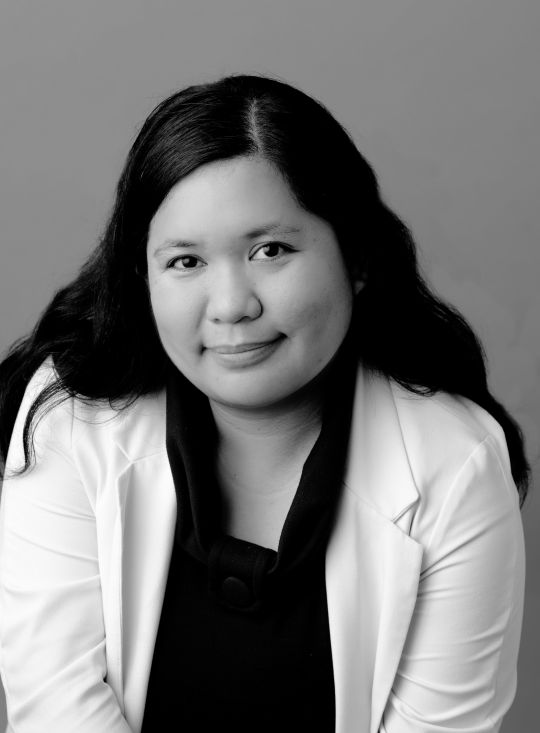
Photo of Giselle General by Sheila Bell, Edmonton Brand Photographers.
About Giselle General
Giselle General has worked in the non-profit sector for over a decade, most recently as the Volunteer and Events Coordinator for the Edmonton Community Legal Centre. She serves as the Chair of the Edmonton Transit Service Advisory Board, Program Director with the West Meadowlark Community League, Board Secretary of the Edmonton Multicultural Coalition, and a District Representative with the Edmonton Federation of Community Leagues. Giselle is a columnist for the Alberta Filipino Journal, a local ethnic paper in Edmonton. In the 2021 Edmonton Municipal Election, she placed second in the City Councillor race for Ward sipiwiyiniwak. Giselle has been featured by CBC, CTV, and Global Edmonton, as well as various local podcasts such as “What’s the Tsismis” and “The Broadcast.”
Giselle General immigrated to Canada at 16 years old. She and her younger brother were sponsored by relatives after they became orphans due to a vehicular accident killing their parents and sister. She completed a Bachelor of Commerce Degree from the University of Alberta School of Business. She enjoys volunteering, writing, sewing, and creating mixed-media artwork using recycled materials. She has self-published a book of poems, The Humanity in Me and writes for her blog, FilipinaYEG. Giselle lives with her husband Corey in Edmonton.
0 notes
Text
“I Am YEG Arts” Series: Sharon Rose Kootenay & Jason Symington
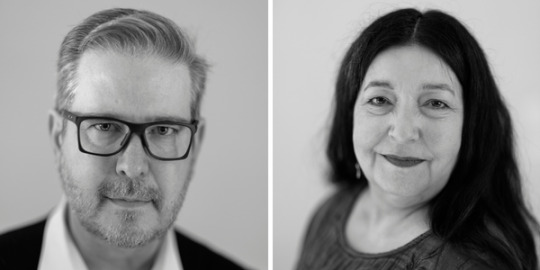
Jason Symington (left) and Sharon Rose Kootenay (right). Photos by Jason Symington.
If the two fit, collaborate? For Sharon Rose Kootenay and Jason Symington, it was never a conundrum. Outstanding artists in their own rights, this duo’s collaborative practice is a natural extension of their friendship and respect for one another’s creative practices. Centred on the extensive conversations they have about life, death, love, and art, their public artwork references both Kootenay’s traditional Métis-Cree teachings and Symington’s exploration of visual rhetoric and the zeitgeist.
Friends, artistic collaborators, and seekers at heart—this week’s “I Am YEG Arts” story belongs to Sharon Rose Kootenay and Jason Symington.
How did you first become involved in working with each other? And why do you think the partnership works?
J.S.: We met a few years ago in a photography class I was teaching. After class, Sharon and I would have long discussions about art, photography, and everything else. When we collaborate, we discuss the concept, design, feeling, audience, etc., and there is always a healthy back and forth. I think the success of our partnership stems from these chats. We both like to talk, but we are also excellent listeners, so it’s like the chats have never ended.
S.R.K.: As Jason mentioned, he was my photography instructor… but what he didn’t say was that I was utterly hopeless at it! Of course, the best part of the class was meeting Jason, so we remained very close friends and eventually began an artistic collaboration that brought our strengths into a cohesive and rewarding public-art practice. I think our partnership works because of our friendship—it’s built on the love and respect we have for each other. We are both seekers at heart, striving to communicate, to gain deeper understanding, and to speak as artists.
What themes are you drawn to in your work together? And how do they represent your sensibilities and strengths as storytellers?
S.R.K: I would say that the recurring themes in our work are those of redemption, compassion, and mysticism communicated in ways that are recognizable and only slightly beyond reach. There is a sense of otherworldliness that is expressed through our collaboration that reflects our discussions on spirituality, childhood memories, and land-based experiences.
Tell us about someone who’s mentored you or helped set you on your path.
J.S.: There are a few people I could mention here. But I think going back to the beginning of my art career is where I developed the most as an artist. A special thanks go out to Darci Mallon and Cherie Moses. In very different ways, these fantastic artists/instructors directed me to become the artist I am and are still in my head, making me accountable for my work.
S.R.K.: My maternal grandmother, Flora Lambert, was instrumental in helping me to develop a sense of being, as both a young mother and a fine-craft artist. Flora was a talented, nurturing, and generous maker, spending her time creating gifts for those she loved. She set a wonderful example for me, encouraging me to make art and to stay true to our Métis heritage and family values.
What’s one piece of advice someone gave you growing up that turned out to be true. What’s one piece that didn’t hold up?
J.S.: Gary Neil Kennedy, in a one-on-one during my undergrad at NSCAD, told me I needed to understand my work from both sides: my side and the viewer’s side. It's been the way I’ve looked at my work ever since. I can’t say that I remember a piece of advice that hasn’t held up. I mean, there has been advice that wasn’t good. You just hope you recognize it before it goes bad.
S.R.K: Years ago, I took a Myers-Briggs Indicator Personality Type Test. The results left me with only two occupational choices: librarian or artist. Luckily for me, I followed both these career paths and found a lot of satisfaction in each of them. Coincidentally, Myers-Briggs is based on Jungian psychology, which has remained compelling and continues to inform my artistic practice to this day. The only advice I recall that hasn’t held up was someone telling me that I needed to stop being interested in so many things!
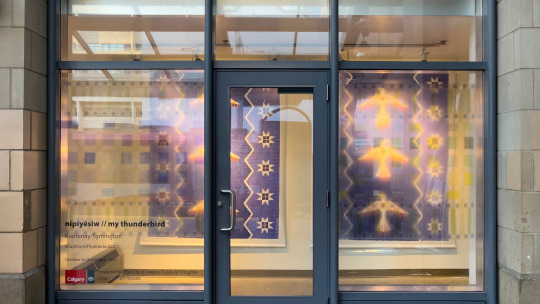

Nipiyesiw // My Thunderbird (top) and Kaskitewastim // Dark Horse (bottom) by Sharon Rose Kootenay and Jason Symington. Photos provided by the artists.
What does community mean to you, and where do you find it?
J.S.: Community is essential. It gives you support to create when the world around you might not know what it is you are trying to accomplish. I have been fortunate to have a readymade community through teaching. I am surrounded by practicing artists across multiple disciplines and by engaged students who want to challenge the system. Partnering with Sharon is also a wild ride, as she knows everyone.
S.R.K.: The Edmonton arts community is wonderfully vibrant, offering a constant source of creative ideas, kindred spirits, and fun events filled with amazing works of art, literature, and music! I am always happy to be amongst fellow artists and those working within the arts sector. This is the community where I thrive, and I appreciate it so much!
What is it about public art that inspires you not only to create it but to champion it?
J.S.: The connection to the audience. Public art is essential because it engages people in their environment. Look at Anish Kapoor’s Cloud Gate, Louise Bourgeois’ Maman, Tino Sehgals’ Special Project Art City, or Jean-Paul Riopelle’s La Joute. These works don’t just engage with the people who live near them, they engage with people from around the world.
S.R.K.: Through ongoing conversations with Jason, I was able to understand and connect more fully to the practice of public art. Creating a dialogue with Jason that ripples out to an audience inspires me and holds great appeal. It’s the ongoing conversation and feedback that becomes the important thing, especially in the age of social media.
When you’re taking a break from a project, what will we likely find you doing?
J.S.: I don’t do very well taking breaks. If Sharon and I aren’t working on a project together, I am working on personal projects, photography, screenplays, and documentaries. If I am not working, I watch films and hang out with my family.
S.R.K.: As a beadworker, I thrive on a creative, daily routine that keeps me calm and centred. Because beading is such a slow-stitch craft, some of this daily work becomes part of the visual catalog that Jason and I will draw from for our collaborative projects. I also enjoy visiting with friends, live music, reading, and gardening.
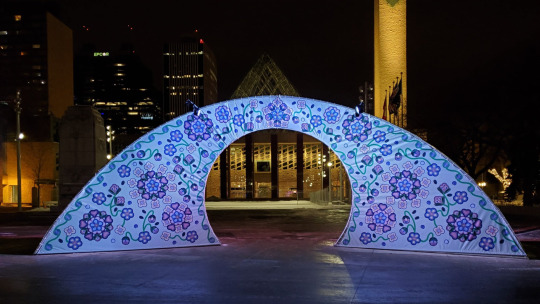
Transformation: Promise & Wisdom by Sharon Rose Kootenay and Jason Symington at the 2021 Works Art & Design Festival. Photo by the Edmonton Downtown Business Association.
Tell us a little about what you’re currently working on together or hoping to explore next.
We are currently working on a larger mobile public artwork that continues our exploration of representation, and the “other.”
Describe your perfect day in Edmonton. How do you spend it?
J.S.: It would be a day in late July or early August. Hot, but not crazy hot. I would casually kayak down the North Saskatchewan River with my family and friends. Seeing Edmonton from the North Saskatchewan River is something not many people do, and it is impressive.
S.R.K.: I would also be on the move—driving my car through the city with family or friends riding shotgun—down Groat Road, across Dawson Bridge, touring through old neighbourhoods and places of connection. Windows down and singing along to a vintage playlist!
What excites you most about the YEG arts scene right now?
J.S.: Potential. I think the YEG arts scene keeps getting more robust due to the potential of the artists working in and around Edmonton. It is also great to see the growing variety of mediums exhibited in the city, and kudos to the people making things happen here.
S.R.K.: I am quite excited by the new work being created by young Indigenous artists of all genres. As a senior artist and long-time Edmontonian, it’s been a wonderful thing to witness the evolution and presentation of Indigenous art forms, from the late 1970’s to the present day.
Want more YEG Arts Stories? We’ll be sharing them here all year and on social media using the hashtag #IamYegArts. Follow along! Click here to learn more about Sharon Rose Kootenay and here for more info about Jason Symington.
About Sharon Rose Kootenay & Jason Symington
As a Métis-Cree artist, Sharon is inspired by traditional Native women’s creative practices, her grandmother, Flora, and her sisters, as well as historical and contemporary artists. Sharon’s beadwork transcends boundaries and references traditional teachings, the Female Gaze, and the transmission of cultural lifeways. The designs Sharon creates speak to the spiritual realm, the current socio-political climate, and environmental issues. Her work demonstrates the authentic cultural perspective of constructing an open and honest dialogue with the viewer to foster a greater understanding and appreciation for all peoples.
Jason is a conceptual artist who uses visual rhetoric to engage his audience. He incorporates theory, concept, and various media to create his messaging. Theories of alienation, identity, sexuality, and the “other” play dominant roles in Jason’s work. The media vehicles (stills, motion, audio, etc.) delivering his messaging operate through the codes and conventions of the zeitgeist. The goal of Jason’s work is to interpolate his audience to gain greater insight into the “other.”
Sharon and Jason’s collaborative practice is an extension of their friendship and respect for each other’s creative practice. The collaborations centre on the extensive conversations the duo has about life, death, love, and art.
0 notes